
Valley Spirit Taijiquan
Taijiquan Staff Aikido Jo Do Karate Shaolin Sticks Wudang
Cloud Hands Blog
Taijiquan
Qigong
Home
Disclaimer
Warning: Practicing with Staff Weapons Can Be a
Dangerous Activity for Adults
![]()
Staff Weapons
Jo, Bo, Gun, Staff, Cane,
Zhang, Walking Stick,
Pole, Spear, Short Staff, Stick, Rod
Bibliography, Links, Resources
A Note to Readers: The
Cloud Hands website has been online continuously since 2001.
In 2008, over 1,900,000 webpages (excluding graphics) were
served to readers
around the world from the Cloud Hands website.
Since 2005, I have also provided an associated
blog to point to changes and
additions at the Cloud Hands website: Cloud Hands: Mind/Body Movement Arts.
Since Cloud Hands is a very well-established and stable website, it provides
readers with a good and secure starting point for their online research into
Taijiquan and Qigong. The Cloud Hands website is funded entirely by
Green Way Research, with
volunteer efforts by Michael P. Garofalo.
Unfortunately, as everyone knows, many other websites and webpages appear and
then disappear from the Internet scene. Authors do not pay to keep up
their web hosting services, loose a "free hosting" option, or decide to remove
webpages for various reasons. Consequently, links to some good webpages become
invalid and files are no longer found on the Internet. You may find a some of these "dead
links" to nonexistent webpages cited below; and, there is no way to avoid this
troublesome situation. For this reason, when you do find a good and useful
webpage, be sure to save the webpage to a folder on your hard drive or server.
I welcome and encourage your suggestions for how to improve
this webpage. Your comments, ideas, contributions, and constructive
criticism are encouraged. Send your suggestions to
my email box.
Aikido Information, Links, Resources, Guides
Aikido of Manhattan, Aikido Jo Practice 2:12 Minutes Video
Aikido Jo - Google Video Search
Aikido Jo Katas: 13, 31, 25
Video Clips
Right and front views.
Aikido Short Staff:
Way of the Short Staff
Aikido 13 Jo Kata. Right
View.
Aikido 13 Jo Kata. Aikido World for Beginners.
Aikido 13 Jo Kata and 31 Jo Kata Videos.
Ki Shin Tai Dojo (Look in video clips)
Aikido 13
Jo Kata, Video clip, 16 seconds. Wałbrzyski Klub Aikido
Aikido 31 Jo Kata.
By Stefan Stenudd. 13KB. Photographs and brief descriptions.
Aikido 31 Jo Kata with Awase. By Jonathan Diesch. A two
person kata.
Aikido 31 Count Jo
Kata and Kumi Jo. By Jonathan Diesch. Descriptions.
Aikido 31 Jo Kata No Kumi
(Iwama Ryu) Saito Sensei
Aikido 31 Jo Kata.
Demonstrated by Saito Sensei. Narration in French. UTube, 5:34.
Front view, side view, footwork view,
Aikido 31 Jo Kata.
Written and graphical instructions.
Aikido 31 Jo Kata and 13 Jo Kata Videos.
Ki Shin Tai Dojo (Look in video clips)
Aikijo - Staff Techniques in Aikido. By Morihiro Saito of Iwama
Aikido. Instructional DVD, 45 minutes.
This video includes: 31 Jo Kata, 20 Jo Suburi, 31 Jo Kumiko, 10 Kumijo, and 13
Jo Awase.
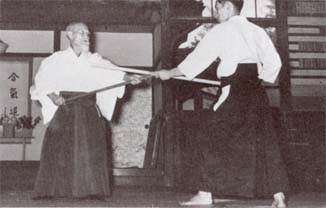
Aikido Founder Morihei Ueshiba practicing Jo techniques with his son.
All Good Ideas:
Collectable Walking Sticks and Canes for the Discerning Customer
Alphabetical
Index to the Cloud Hands: Taijiquan and Qigong Website
Ba Gua Zhang ( Pa
Kua Chang): Bibliography, links, resources, quotes, and notes.
Circle walking internal martial arts. By Michael P. Garofalo.
Baguazhang
includes a staff form.
Ba Ji Staff. Taught by Shifu Jiang Jian-ye.
This 36 posture staff form was created by Grandmaster
Wu Lian Zhi. Produced by Shifu Jiang Jian-ye of the Capital District Tai Chi and Kung Fu
Association of New York,
29 West Dillenbeck Drive, Albany, NY 12203. VHS videotape, 121
minutes. Website:
Jiang's
Tai Chi Videos.
Bata - Irish Stick Fighting
- Uisce Beatha Bata Rince. Whiskey Stick Dancing.
Bo Karate (72" Hardwood Staff)
Bo:
Karate Weapon of Self-Defense. By Fumio Demura. Santa Clarita,
California, Ohara Publications, 1976. 183 pages. 36th printing,
2002. ISBN: 0897500199. VSCL.
British Quarter Staff
Association
"Broadsword and Singlestick - with Chapters on Quarter-staff, Bayonet, Cudgel, Shillalah, Walking Stick, Umbrella and other Weapons of Self Defence; The Quarter-Staff" By Allanson-Winn, R.G. and C.
Phillipps-Wolley.
London : George Bell & Sons. 1st edition, 1898.
Broadsword
(Saber, Dao) and Taijiquan
Bibliography, links, resources, quotes, notes.
Canary
Islands Stick Fighting: Juego Del Palo
Death Valley, California
Mike Garofalo, Hiker with Staff
Canes, Zhang Quan, Walking Sticks: Information, Links, Bibliography, Media, Forms

Chen Style Five Tigers and Group Sheep Staff. Instructional videotape
by Shifu Jiang Jian-ye. Instructional videotape, 117 minutes, color.
Traditional Chen Village. 44 Forms with Internal Art. Capital
District Tai Chi and Kung Fu Association of New York. Albany, New York, CDTKA, 2004. MGC. Use a medium staff, wax wood, flexible, about 6
feet in length.
Chen Style Five Tigers Swarm a Herd of Sheep Staff Form. List of
movements.
Chen Tai Chi Short Whip Staff. Taught by Shifu Jiang Jian-ye. 120 minute VHS
videotape. A 147 movement form in the Chen style, created by Hong Jun-sheng, an indoor
student of Chen Fa-ke. Produced by Shifu Jiang Jian-ye of the Capital District Tai Chi and Kung Fu Association of New York, 29 West
Dillenbeck Drive, Albany, NY 12203. Website:
Jiang's
Tai Chi Videos.
Chen Taijiquan, Pole, Weapons -
Bibliography, Links, and Resources Includes notes and
description of the 18 Movement Chen Pole Form.
Chen Taijiquan, Spear:
Bibliography, Links, and Resources
Chen Taijiquan, Staff,
Gun, Weapons, Theory and Practice
Choy Li
Fut Pear Blossom Spear and Staff. By Doc Fai Wong.
Cloud Hands Blog: Taijiquan and
Qigong
The
Complete Book of Tai Chi Chuan: A Comprehensive Guide to the Principles
and Practice. By Wong Kiew Kit. Shaftesbury, Dorset, Element,
1996. Index,
bibliography, 316 pages. ISBN: 1852307927. The reasons for Wu Tang
Tai Chi Chuan
favoring the sword over the staff, and for its limited use of weapons, are
discussed in the chapter on Tai Chi weapons, pp. 278-285.
The
Complete Guide to Walking for Health, Weight Loss, and Fitness.
By Mark Fenton.
Lyons Press, 2001. 288 pages. ISBN: 1585741906.
The
Complete Walker III: The Joys and Techniques of Hiking and
Backpacking. By Colin Fletcher. Illustrations by Vanna Prince. Third Edition, Revised,
Enlarged and Updated. New York, Alfred A. Knopf, 1968, 1984. Index, 668 pages. ISBN:
0394519620.
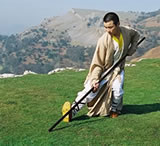
Kung Fu Master Xing Du from the Shaolin Temple practicing a long staff form.
"Cultivating Jin with T'ai Chi Spear." By Gerald A. Sharp. T'ai Chi: The International Magazine of T'ai Chi Ch'uanVolume 27, No. 2, April, 2003, pp. 40-47. Includes many photographs.
Dao (Saber, Broadsword) and Taijiquan
Bibliography, links, resources, quotes, notes.
Eight Section Brocade
Qigong By Michael P. Garofalo. 280Kb+. History and
purpose of
this popular chi kung practice. Descriptions for each of the eight
movements, health benefits,
comments, variations, extensive links and bibliography, resources, quotations,
animated
.gif photographs of the movements, and charts.
Eight Immortals Staff, Ba Xian Gun, Chinese Kungfu Weapons, 1 minute and 32
seconds
Eight Immortals Staff, Ba Xian Gun, Chinese Kungfu Weapons, 1 minute and 34
seconds
![]()
Equipment - Staff
Weapons
Vendors, Distributors, Manufacturers
All Combat Martial Arts Supplies: Staff and Bo Weapons
Custom Bo Staffs.
Created by Mark S. Taylor, Woodtrades.
Equipment Notes, Sizes, and Comments for Staff Weapons
Jo: Information, Links, Bibliography, Resources
Pikes,
Pole-Axes, and Staff Weapons. From Armouronline.
Purple Heart Wooden Swords and Staff
Walking Sticks:
Catalog and Links The Sei Do Kai Catalog.
Wampanoag
Carved Walking Sticks
Wing Lam Enterprises -
Bo and Staff
Weapons I have been satisfied with my many bo and staff purchases from
WLE.
![]()
Egyptian
Royal Regalia -
Scepter and Staff
Exposition of the Original Shaolin Staff Method
少林棍法闡宗
Shàolín Gùnfǎ Chǎnzōng (in Chinese).
Chéng Zōngyóu, 程宗猷 [c.
1621].
Fatal
Flute and Stick Forms: Wah Lum Kung Fu. By Poi Chan.
Unique Publications, 1985. 151 pages. ISBN: 0865680590.
The
Fighting Staff. By Dwight C. McLemore. Paladin Press, 2010.
234 pages. ISBN: 1581607148.
Five Famous Staff Forms of China
Five-Tiger Killing Sheep Cudgel. Instructional DVD, 46 Minutes.
Demonstrated and explained by Master Chen Qingzhou. 46 Minutes.
Ancient respected Chen Style Taiji Quan. In Chinese, with English
subtitles. ISBN: 7887212545. MGC.
Five Tigers Killing Sheep Staff
Five Tigers Swarming Sheep (Chinese:
五虎群羊棍;
Hanyu
Pinyin: wǔ hǔ qún yáng gùn)
The Forbidden Kingdom. A major motion picture, distributed in 2008. Starring Jackie Chan (Lu Yan the drunken Taoist immortal and old Boston pawnshop owner), Jet Li (Buddhist monk and Monkey King), Michael Angarano (Jason, an American teenager), Liu Yifei (Golden Sparrow, a beautiful young woman seeking revenge), Li Bing Bing (the White Haired Witch), Collin Chou (Evil Warlord). Directed by Rob Minkoff. Martial Arts director; Yuen Woo-Ping. Screenplay by John Fusco. From the Lion's Gate Studio. 104 minutes, DVD, with many extra features. The magical staff of the Monkey King must be returned to free the Monkey King imprisoned by an evil warlord, and a team of four (Chan, Li, Angarano, and Yifei) go on a quest and battle the evil doers (Bing, Chou). Plenty of sorcery and high flying and dramatic martial arts fighting, excellent cinematography, superb scenery in China, and Chinese myth, lore and philosophy. Aspects from numerous films are included in this tale. In English. The plot will appeal more to persons under 20 years of age, followers of Chinese martial arts and lore, lovers of quests and coming of age tales, fanciers of the picturesque, and, of course, for aficionados of the staff. Michael Angarano's character, Jason, is a blend of Daniel LaRusso (Karate Kid) and Bilbo Baggins (Lord of the Rings). Elements from the epic story, Journey to the West, and other characters from Chinese folklore are integrated in this tale.
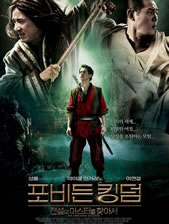
French Stick Fighting (Canne de Combat) Online Video. 2:26 minutes.
French
Stick Fighting (Canne de Combat) Online Video. 3:03 minutes.
Fu Style Wu Dang - Three Spear
Set Instructional videotape by Master Liang, Qiang-Ya.
Gabrielle's Staff
Techniques By Donald Plunkett. 13K
Garofalo, Michael P., M.S.
Instructor at Valley Spirit
Taijiquan. Mike has been publishing on the Internet
since 1992. Mike began his practice of Taijiquan and Qigong in 1986.
He has taught Taijiquan and
Qigong since 2000; and
Yoga since 2004. He
teaches at the Valley Spirit
Taijiquan Center and at the
Tehama Family Fitness
Center, both in Red Bluff, California. He teaches Yang and Sun Style Taijiquan,
Taiji sword and cane,
and various styles of Qigong and Yoga. His many
web publications (e.g., The
Spirit of Gardening, Cloud Hands,
Months, etc.) are widely
cited and rank high in search engines, and he serves up over 3,000,000 webpages
(excluding graphics) each year. He is currently studying
Sun Style Taijiquan. He is an avid and
knowledgeable gardener, and
lives in a rural area in Northern California. He is a
semi-retired library administrator, grant writer, webmaster, and technology
manager. He has been publishing at
Green Way Research since 1999.
You can contact Mike by email or
by cell phone at 530-200-3546.
Glossary of Tai Chi
Chuan (Taijiquan) In English and Chinese. By Mike Garofalo
Goju-Shorei Weapons
System. By Master Dave McNeil. Cane system. A detailed textbook (288 pages). videos, canes and other products are offered for
sale.
Good
Shepherd (Jesus Christ) images
Green Way Blog. By
Michael P. Garofalo.
Gu Shen Taijiquan. Valley Spirit Tai Chi Chuan
Journal. A journal/blog with reflections, notes, suggestions, references, questions and answers, links and quotations about Tai Chi Chuan and Chi Kung. By Michael P. Garofalo.
Green Way Research
Red Bluff, California
Hafted Weapons in
Medieval and Renaissance Europe. By John Waldman.
Hapkido
Weapons: The Cane. Published by Kwang Sik Myung, 1990.
ASIN: 9991213554.
History of the
Goju-Shorei Weapons System. By Master Dave McNeil. Cane
system.
Hung Chur Kwun - The Hung Gar Monkey Pole
Set
Hsing I Chuan: Bibliography, Links, Resources, Quotes, Notes
Index to the Cloud Hands Website
Internal Power Training with Bare-Hand, Staff and Equipment. Performance
and instruction by Shifu Jiang Jian-ye. Instructional
videotape, 90 minutes, color. Traditional Chen Village. Capital
District Tai Chi and Kung Fu Association of New York. Albany, New York, CDTKA, 2002. MGC.
Irish
Stick Fighting, Faction Fighting, Celtic Martial Arts, Bata
Irish Stick Fighting -
Uisce Beatha Bata Rince. Whiskey Stick Dancing.
The
Japanese Short Staff. By Don Zier and Tom Lang. Burbank
Publications, California, Unique Publications, 1985. Glossary, 97 pages.
ISBN: 0865680582. VSCL.
Jian
(Sword) Taijiquan: Bibliography, Links, Resources, Quotes, Notes 180Kb.
"Jin Yiming's Walking Stick Exercises." By Jin
Yiming. T'ai Chi: The International Magazine of T'ai Chi Ch'uan, Vol. 29, No. 1, February 2005, pp. 39-47.
A 22 form
exercise system. Descriptions of each exercise and line
drawings.
Jo: Art of the Japanese Short Staff. By David Lowry and Mike
Lee. Black Belt Communications,
Inc., 1987. Eight printing, 2002. Glossary, 191 pages. ISBN: 0897501160.
VSCL.
Jo Do: Way of the
Short Staff: Jodo, Aikijo, Jojutsu, Gun Quan,
Zhang Quan. By Michael
P. Garofalo.
Jo Karate (50" Hardwood Short Staff)
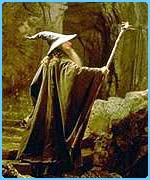
Gandalf the Wizard and his magical staff.
Lord of the Rings
Bojutsu: The Staff and Stick Arts of Hontai Yoshin Ryu Jujutsu.
By Stephen Fabian. 20Kb.
Bo:
Karate Weapon of Self-Defense. By Fumio Demura.
Ohara, 1976. Black Belt
Communications, 1989. ISBN: 0897500199. Book
and instructional VHS videotape.
Bo Katas: Bushido
On-Line Martial Arts
Isshinryu Weapon Kata: Bo and Sai. Demonstration and instruction by Sensei
Mike Reeves. Instructional DVD, 70 minutes. Includes four Bo weapons
forms: Tokumine-No-Kun, Urashi-Bo, Shishi-No-Kun, and a Bo Kumite (two
person practice set). MGC.
Turtle
Press
Jo: Art of the Japanese Short Staff. By David Lowry and Mike
Lee. Black Belt Communications,
Inc., 1987. ISBN: 0897501160.
Jo Do: Way of the
Short Staff: Jodo, Aikijo, Jojutsu, Gun Quan. By Michael
P. Garofalo.
Jo: The Combat Weapon of
Japan and Okinawa. By William Durbin.
Jo: The
Japanese Short Staff. By Don
Zier and Tom Lang. Unique Publications,
1985. 102 pages.
ISBN: 0865680582.
Karate Bo Staff, Clint Leung, 1 minute and 33 seconds
Kobudo: The Okinawan Weapons Arts.
By Charles C. Goodin.
Martial Arts
Techniques for the Cane and Short Staff. By Michael P. Garofalo, M.S.,
Valley Spirit Taijiquan, Red Bluff, California. January 2009. 100Kb.
Includes Strikes - Two Hands, Strikes - One Hand, Blocks - Two Hands, Blocks -
One Hand, Sweeps, Pull Downs, Chops, Jabs, Pokes, Punches. The document
provides a bibliography, links, and resources. The document includes brief
descriptions for each short staff and/or cane technique.
Okinawa Kobudo, Bo Kata: Cho Un No Kon, Theo Theloesen, 1 minute and 15 seconds
"The Bo is the Japanese equivalent of the wooden staff. This martial arts weapon
is normally 6 foot in length and made from a variety of hard woods, the
strongest being the Okinawan Iron Wood. The Bo is one of the more popular
weapons to learn and quite practical as a broom stick or other similar objects
can be used in its place. Depending on the position of the hands the Bo can be
used at either short or long range. Training with the Bo is known as Bojutsu."
- Lyon Karate
Return to the Index at the Top of This Webpage
![]()
Kung Fu Advanced Staff Techniques. By H. C. Chao. Unitrade Ltd.,
1983.
Photographs
of Kung Fu Staff Exercisers
Pole Weapons -
Wikipedia Index
Praying Mantis Staff With Applications. Taught by Shifu Jiang Jian-ye.
122 minute VHS
videotape. A 25 posture combination of Seven Stars, Plum Flower, and Liu He Praying Mantis
styles. Produced by Shifu Jiang Jian-ye of the Capital District Tai Chi and Kung Fu
Association of New York, 29 West Dillenbeck Drive, Albany, NY 12203. Website:
Jiang's
Tai Chi Videos.
Push Hands (Tui Shou)
in Tai Chi Chuan. Links, bibliography, quotes, notes. 25Kb.
"The Quarter-Staff: A Practical Manual". By Thomas A.
McCarthy. London : W. Swan Sonnenschein and Co., 1883.
Rods - Riverwood
Rods and staffs in religion. Bible
concordance.
Saber (Broadsword, Dao) and Taijiquan
Bibliography, links, resources, quotes, notes.
Self-Defense with a Walking Stick. By E. W. Barton-Wright.
1901. 50K. Illustrations and
commentary.
![]()
Guard the Mountain Staff
Form. Demonstrated and taught by Qing Feng-Qinis. Shaolin
form. In Chinese.
Eyebrow Staff of
Shaolin Instructional VCD. Quimei Gun.
The Ferocious Enchanted Staff of
Ancient Monks. By Dr. Leung Ting. 95 pages.
This book consists of the origination, form, and application of the “ferocious enchanted staff” –
a translation from a hand-transcribed book of ancient times!
Five Tigers Swarm a Herd of Sheep Staff Form. List of movements.
Used in Shaolin staff practices, kung fu, and Chen Style Taijiquan.
Kung
Fu Master Xing Du Monk using staff as a
Kung Fu Weapon.
Plum
Blossom Staff of Shaolin. Performed and demonstrated by Shi Yongyue.
Explained by Shi Deci. Language: Mandarin Chinese. Published by
People's Physical Education Publishing House. ISBN 7887210437. As a
basic weapon, the Shaolin cudgel skill is one of the important Shaolin kungfu.
Before the founding of Shaolin Monastery, the local hunters often took tree
branches as the stick to play martial arts. Because cudgels and sticks can be
found everywhere in the forest, so it is very easy for Shaolin monks to take
them as their weapons for defending themselves. That's why the Shaolin fighting
monks especially pay attention to the training of Shaolin cudgel skills. The
routines of Shaolin cudgel skills handed down from ancient time to the present
include Qimei (eyebrow) cudgel, Fenghuo (wind-and-fire) cudgel, Yuanhou
(ape-and-monkey) cudgel, Yinshou (negative hand) cudgel, Yangshou (positive
hand) cudgel, Meihua (plum blossom) cudgel, Yunyang (wind-and-sun) cudgel and
etc. Shaolin Plum-blossom Staff is characterized with hooking, holding up,
sweeping, hanging, splitting and teasing. It has lots of changes and good
functions of strengthening body. Step by step the techniques are demonstrated,
repeated and instructed by Shaolin master. In this video you will see many
practical applications & demonstrations."
Shaolin Kung Fun
Twisting Spear. Instructional DVD.
Shaolin Kung Fu
List of Forms: Staff Weapons. Plum Publications.
Shaolin Qimei
Cudgel Demonstration by Master Shi GuoSong of the oldest of the
Shaolin hand weapons - the cudgel. Sometimes called the "ancestral weapon".
Legend has it that it became famous after 13 cudgeling monks saved the Tang
emperor. The cudgel can be used to channel the strength of the entire body and
is famed for it's speed as fast as the wind.
Shaolin Short
Staff, Cudgel, Cane
Shaolin
Staff Form. Online Video Instruction. Kung Fu Bo Staff Movements
1-6.
Moves
1-6.
Moves
7-12. Moves 13-18. Move3 19-24.
Shaolin Staff. Taught by Shifu Jiang Jian-ye. 80 minute VHS
videotape. Produced by Shifu Jiang Jian-ye of the Capital District Tai Chi and Kung Fu
Association of New York,
29 West Dillenbeck Drive, Albany, NY 12203. Website:
Jiang's
Tai Chi Videos.
Shaolin Staff (Gun), Performer: Dennis Navikov, 2 minutes and 6 seconds
Shaolin Taizu Short Cudgel. Instructional DVD by Li Chengxiang.
In Chinese with English and Chinese subtitles; 66 minutes. Shaolin Taizu
Short Cudgel (Staff) is sometimes called Whip pole. The length of the cudgel is
about thirteen times of the palm width. It consists of five Yinshou techniques
and seven yang shou techniques. With quick and practical movements, and the
natural posture, you can practice it as a continuous routine or freely combine
the different techniques into a set exercise.
Shaolin Yin-Yang Stick Instructional VCD.
Taiji and Shaolin Staff Fundamental Training. Performed by Yang,
Jwing-Ming, PhD. Boston,
YMAA, 2003. Instructional VHS
videotape. 90 minutes. ISBN: 1594390088.
"In
ancient times, Shaolin monks practiced different kinds of staff weapons. Qi Mei
Gun 齊(齐)眉棍, is a kind of staff (this is not a set name) which was unique to the
Shaolin Monastery. During Shaolin's early history, knives and edged weapons were
not allowed in the monastery, and in fact were illegal, except for those used as
tools used for cutting firewood, and kitchen utensils. However, because Buddhist
monasteries, and in particular the large public ones, contained large granaries
and other provisions made them attractive targets for robber bands such as the
Lülin (Green Forest Bandits) and renegade bands of rebels and invaders, staves
were used to defend the monastery. According to our older generations these
non-alarmed staves were kept at the entrance gate. Those who had learned the
martial arts for one year were taught staff fighting so that they could protect
the monastery. The correct length of this staff is measured to the users eyebrow
- that is why it is called a ‘齊眉棍’ (’Same height’/Level with, the Eyebrow,
Staff). This weapon was used by both Songshan Shaolin and southern Shaolin
styles. The old Songshan Shaolin Qi Mei Gun sets are quite a bit different from
the Southern sets in terms of technique, the way the weapon is held, and the way
power is generated. The ‘southern’ Shaolin, Qi Mei Gun, is a ‘double headed
staff’ and therefore is mostly griped both hands palms down. The Songshan
Shaolin, Qi Mei Gun, has a single ‘head’ and ‘tail’, and is mostly griped with
one hand, palm up, and the other, palm down. I would say that that this weapon
"has fallen into obscurity"."
-
Rik Zak
"The
Boddhisattva
Vajrapani
is the patron saint of the Shaolin Monastery. He was historically worshiped as
the progenitor of their famous staff method by the monks themselves. A stele
erected by Shaolin abbot Wenzai in 1517 shows the deity's vajra-club had by then
been changed to a
Chinese staff,[19]
which originally "served as the emblem of the monk". Vajrapani's
Yaksha-like
Narayana form was eventually equated with one of the four staff-wielding "Kimnara
Kings" from the Lotus Sutra in 1575. His name was thus changed from
Narayana to "Kimnara King". One of the many versions of a certain tale regarding
his creation of the staff method takes place during the
Yuan
Dynasty's
Red Turban Rebellion. Bandits lay siege to the monastery, but it is saved by
a lowly kitchen worker wielding a long
fire poker as a makeshift staff. He leaps into the oven and emerges as a
monstrous giant big enough to stand astride both
Mount Song
and the imperial fort atop Mount Shaoshi (which are five miles apart). The
bandits flee when they behold this staff-wielding titan. The Shaolin monks later
realize that the kitchen worker was none other than the Kimnara King in
disguise. Shahar notes the part of the kitchen worker might have been based on
the actual life of the monk Huineng (638-713).[23]
In addition, he suggests the mythical elements of the tale were based on the
fictional adventures of
Sun Wukong
from the Chinese epic
Journey to the West. He compares the worker's transformation in the
stove with Sun's time in
Laozi's crucible,
their use of the staff, and the fact that Sun and his weapon can both grow to
gigantic proportions."
- Shaolin
Monastery
![]()
The Shepherd's Crook
How to construct, styles and uses.
Short Staff Martial
Arts Practice: Jodo, Aikijo, Jojutsu, Gun Quan. By Michael
P. Garofalo.
Silk Reeling, Chan
Ssu Gong: Links, bibliography, quotes, notes.
Spear and Other Long Range Weapons in China Real Wushu Scholar.
The Spear: Great
Weapons of the Western World
Spear -
Chinese. King of Chinese Weapons "Yang Cheng Fu of the
Yang Family Tai Chi fame always carried a short single-head spear for
protection. It served the dual training function of a straight sword and a short
staff."
Spear
Set. Description of practice with staff (gun) instead of
spears. Photographs from the
1931 book by Yang Chen Fu showing T'ien Chao Ling practicing with the staff with
Tung Ying Chieh.
Both men were top students of Yang Chen Fu. 8K. By Chip Ellis.
T'ien Chao Ling practicing with the short staff with Tung Ying Chieh, 1931
Spear
Set II. By Chip Ellis.
Special Taoist Taiji Stick and Ruler Qigong. By Feng Zhiqiang.
Compiled by
Wang Fengming. 205 pages in English, 127 pages in Chinese.
The Staff.
Demonstration and teaching of staff form by Sifu James McNeil. Shaolin
Kung Fu Weapons Series. VHS Videotape, 40 minutes.
Staffs, Canes
and Walking Sticks. By Alan Hoover. Comments on the use of
staffs by
aboriginal peoples in Canada.
Staff Weapon - Google Video Search
Staff Weapons: Bill,
Partisan, Halberd. By De Grasse.
Staff Weapons.
One Hundred and One Antiques.
![]()
Stick Fighting
Escrima, Shinai, French Stick,
Canes, Crops, Fans,
Switches
Canes: Links, Bibliography, Forms, Facts
Explore and Flow, 2-Shinai Sword and Staff Flows, Max Andranov, 16 minutes and
45 seconds
The
Fighting Staff. By Dwight C. McLemore. Paladin Press, 2010.
234 pages. ISBN: 1581607148.
French
Stick Fighting (Canne de Combat) Online Video. 2:26 minutes.
French
Stick Fighting (Canne de Combat) Online Video. 3:03 minutes.
NAFMA Stick Fighting Championships 2006
Short staff or stick weapons: Arnis sticks, Hanbo, Jō
(Japanese stick weapon), Kurunthadi, Kubotan, Otta, Shillelagh, Tambo, Tonfa,
Yawara, Yubi-bo. Long weapons (staff and
spear weapons): Arbir (Indonesian halberd), Bisento (Chinese origin
halberd), Bō (Japanese staff weapon), Eku, Gun (staff), Ji (halberd), Jogo do
Pau (Portuguese Staff and baton), Guan dao or Kwan dao (large Chinese halberd),
Kurunthadi, Ox tongue, Lathi, Pudao (long handled sword), Halberd, Monk's
Spade, Nagamaki (Japanese polearm), Naginata (Japanese polearm), Qiang (spear),
Quarterstaff, Sarissa, Sibat (Filipino/Indonesian spear), Spear, Taiaha (Maori
wooden duelling spear/staff), Kanabō (Japanese iron staff), Yari (Japanese
spear).
The Stick and Cane in Close Combat.
By Tom Lang.
"The result of a
7-year intensive study of grappling techniques with the stick and cane, the book
presents more than 120 jointlocks, takedowns, chokes, holds, disarms, surprise
attacks, rolls, strikes, and exercises with the stick and cane in 750
photographs. These techniques were collected and refined from those described in
more than 120 books and videos on the topic as practiced in several traditions,
as well as from my 35+ years of experience in the martial arts. It is the
largest collection of these techniques yet published."
Stick and Pole Weapons. By George Hernandez. 80Kb. An
informative and detailed overview of this type of weapons.
Stick Fight the Best Online Video 1:31 minutes
Stick
Fighting. By Masaaki Hatsumi and Quintin Chambers.
Kodansha International, 1981. ISBN: 0870114751.
Stick Fighting
Google Video Search
![]()
Subject Index to the Cloud Hands (Taijiquan and Qigong) Website
Sword
(Jian) Taijiquan: Bibliography, Links, Resources, Quotes, Notes
Tai Chi Saber (Dao, Broadsword)
Tai Chi Chuan Walking
Stick. Kung Fu magazine, August 1996. The walking
stick forms are part of the Tchoung style of t'ai-chi ch'uan, developed by Grandmaster
Tchoung Ta-tchen.
Sifu Kurland teaches this
form.
Tai Chi
Spear/Staff/Halbrand By Peter Lim. 4K.
He lists the 13 staff techniques of Tai Chi as; " 1) Open (Kai); 2) Close (He); 3) Burst
(Beng); 4) Split (Pi); 5) Dot (Dian);
6) Bind (Za); 7) Poke (Bo); 8) Hold Up (Liao); 9) Coil
(Chan); 10) Lead (Dai); 11) Slip (Hua);
12) Intercept (Jie); 13) Stab (Cuo)."
Tai Chi
Sword, Saber and Staff. By Stuart A. Olson. Yearning K. Chen
Series, Volume 5. Bubbling Well Press, 1986. ASIN: 0938045032.
Taiji and Shaolin Staff Fundamental Training. Performed by Yang, Jwing-Ming, PhD. Boston,
YMAA, 2004. Instructional VHS
videotape. 85 minutes. ISBN: 1594390088.
Taiji
Staff. By Chip Ellis.
Taoist Secret Style Xuan
Wu Staff. VCD Product. In Chinese. WuDang style
staff demonstrated
and taught by You XuanDe. 2 hours.
Thank You to the following persons for sending me links, references or
information:
Sensei Jason McIntyre 11/2003,
6/16/04, 12/29/05, ; and Peregrine Dace 1/27/2004.
Thunder
Stick Form by Chen Pan Ling A cane form.
Total
Stick Fighting: Shintaido Bojutsu. By Aoki Hiroyuki.
Kodansha Europe, 2000.
140 pages. ISBN: 4770023839.
Traditional Aikido of Santa Rosa. Bo and Jo katas, one person and two person, are part of the training program at this dojo. "O-Sensei, the founder of Aikido, was skillful with both sword and staff, frequently demonstrating the same movements to be effective even while empty-handed." The Bo is a stave, about 7' feet long. A Bo Kata is a formal standardized exercise with the Bo. Bojutsu means the techniques of using the Bo.
Traditional Ba Gua Staff with Applications. Taught by Shifu Jiang Jian-ye.
120 minute VHS
videotape. A 19 movement form in the Ba Gua Zhang style, created by Professor Jiang Zhou
Chu. Produced by Shifu
Jiang Jian-ye of the Capital District Tai Chi and Kung Fu
Association of New York,
29 West Dillenbeck Drive, Albany, NY 12203. Website:
Jiang's
Tai Chi Videos.
Traditional Chen Family Tai Chi Short Staff. Taught by Shifu Jiang
Jian-ye. Two 122 minute videotapes.
This 74 movement form was created by Master Chen Shen-Pu. The form
requires more advanced
physical conditioning and skills. Produced by Shifu Jiang Jian-ye of the Capital District Tai Chi and Kung Fu Association of New York,
29 West Dillenbeck Drive, Albany, NY 12203. Website:
Jiang's
Tai Chi Videos.
Traditional Yang Family Tai Chi Short Staff 104 Forms.
This short staff form was created in 1994 by Xu Minshan, who was an indoor
student of Yang Chengfu. Xu Minshan created the form to combine Yang style Tai Chi Chuan postures with
the traditional Yang style long staff form. This long form, suitable for persons at all skill levels,
is taught using two
instructional VHS videotapes featuring Shifu Jiang Jian-ye (1950-). Tape 1,
Part 1, teaches movements
1-50 of this form (VHS, 112 minutes). Tape 2, Part 2, teaches movements 51
-104 of this form (VHS, 112 minutes).
Produced by Shifu Jiang Jian-ye of the Capital District Tai Chi and Kung Fu
Association of New York, 29 West Dillenbeck Drive, Albany, NY 12203. These videotapes were produced in
2002, and priced at $45.00 each. Website:
Jiang's
Tai Chi Videos. Shifu Jiang Jian-ye began his studies of Wushu in 1955 in China and he was educated in China. He is a physical
education, tai chi, kung fu, and calligraphy teacher. This videotape begins with an introduction of Shifu Jiang,
includes a little history of this short staff
form, includes a number of short staff warm up exercises, and then teaches the
form. Each movement is
introduced, named, and then illustrated. A front view of the movement is
shown as the teacher provides verbal instructions and tips. The front view is repeated and then a back
view of the movement is shown. I find the instructions clear and understandable; and the videotape production
is good.
Shifu Jiang Jian-ye
Yang
Family Short Staff
Traditional
Yang Family Tai Chi Short Staff 68 Forms.
This long form, suitable for persons at all skill levels,
is taught using two
instructional VHS videotapes featuring Shifu Jiang Jian-ye (1950-). "Traditional Yang
Style Tai Chi Staff is a classic weapon routine. This form comes from Grand Master Sun Jixian. At the age of 18
he went to Bejing to study with Grand Master Wang Jiaoyu. Wang Jiayou was an indoor student of Yang
Banhou who was the son of Yang Luchan, the founder of Yang family Tai Chi Chuan."
Traditional Zhao-Bao Family Tai Chi Staff. Taught by Shifu Jiang
Jian-ye. Two 120 minute videotapes.
Includes applications. Produced by Shifu Jiang Jian-ye of the Capital District Tai Chi and Kung Fu Association of New York,
29 West Dillenbeck Drive, Albany, NY 12203. Website:
Jiang's
Tai Chi Videos.
Traditional Xing-Yi Staff with Applications. Taught by Jiang Jian-ye. This 50 posture staff form was created by Ji Long Feng at the end of the Ming Dynasty. Produced by Shifu Jiang Jian-ye of the Capital District Tai Chi and Kung Fu Association of New York, 29 West Dillenbeck Drive, Albany, NY 12203. This VHS videotape is 120 minutes long. Website: Jiang's Tai Chi Videos.
Tsunami Shotokan Karate
Cane Work
Twenty Basic Jo Techniques
21 Kb.
Using the Pole to Integrate the Body. Interview with Chen Zheng Lei, by
Marvin Smalheiser.
Translated by C. P. Ong. T'ai Chi: The International Magazine of T'ai Chi Ch'uan: Volume 27, No. 2, April, 2003,
pp. 14-19.
Valley Spirit Journal.
By Mike Garofalo.
The Walking Stick - Canes - Self-Defense
The Walking Stick: Hiking and
Walking - Sticks, Poles and Staff
Walking Stick Method of
Self Defense. A twelve part manual created by Mr. H.G. Lang who was a British Officer of the Indian Police. It was written in 1923. PDF
format.
Waving Hands Like
Clouds: Taijiquan and Qigong
Way of the Short
Staff. By Michael P. Garofalo, M.S. A comprehensive guide to the
practice of the short staff, cane, jo, walking stick, gun, zhang,
whip staff, 13 Hands Staff, and related wood short staff weapons. A
detailed and annotated guide, bibliography, lists of links, resources,
instructional media, online videos, and lessons.
Includes use of the short staff and cane in martial arts, self-defense, walking
and hiking. Separate sections on Aikido Jo, Cane, Taijiquan cane and
staff, Jodo, exercises with a short staff, selected quotations, techniques,
selecting and purchasing a short staff, tips and suggestions, and a long section
on the lore, legends, and magick of the short staff. Includes "Shifu
Miao Zhang Points the Way." Published by Green Way Research,
Valley Spirit Taijiquan,
Red Bluff, California. Updated on a regular basis since October, 2008. Filesize: 275 Kb. Related to Mike's popular webpage on the
Staff.
Weapons -
Poles Wikipedia Index
Western China
Staff Sets: 30 VCD's from Plum
Publications. "The Western region of China is often associated with Taoism
and the interchange of religious ideas from India. This style has a huge amount
of stick work. Single stick, double jointed staff (Big Sweeper), double short
sticks (Nunchaku): all are here with an unusual number of high quality sets.
Here we have a variety of performers all giving renditions of staff skills. This
style has a huge repertoire of staff work including single short, single long,
double short, big sweeper and more. There are not only a lot of sets but the
typical eyebrow length staff is used in a variety of ways including reverse
grip. Along with Shaolin, which for a time was probably the greatest staff style
in the world—boasting 200 sets— the Western Staff is a truly masterful selection
of forms." Bian, Tan Bian (Single Whip, Whip Like) forms, and Gun forms.
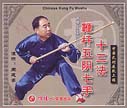
Western Staff Style Husk Staff. Cai Zhi Zhong performs Ku Zi Gun. "This is a three VCD set with no forms on it. Instead there are many exercises. This is a great series for people who want to really practice stick arts. Each section contains a few moves done symmetrically with a refrain, something like the staff version of a short Tan Tui set. Each section is named, performed, repeated and then broken down. Great for instructors and students who want practice patterns. This rare art was once the property of the Gao family, Gansu, and has only recently come forward. Excellent routines." Plum Publications. VSCL.
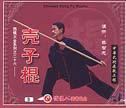
Wind
Sweeps Away the Plum Blossoms: The Principles and Techniques of Yung Style
Tai Chi Spear and Staff. By Stuart A. Olson. Bubbling Springs Press, 1986.
ISBN: 0938045008.
Aikido
Founder Morihei
Ueshiba with Jo, 1966
Quality
Posters from Aikido Journal
Why train with the Bo? Aikido uses a long staff for a short form, the Bo Kata.
![]()
Wudang Staff
Wutang Mountain Taoist KungFu
Eight
Immortals Staff Wudang Ba Xian Gun. UTube, 1:34.
Pan Long (Winding Dragon)
Staff Form
Winding Dragon Wudang Staff.
Pan Long Men Wudang Martial Arts. Featuring Sun, Xiang.
Wu Dang Martial Arts: Bibliography, Links, Quotes,
Resources, Notes, Lessons
Wudang Short Staff.
Featuring Master You, Ming Sheng. Wudang Song Xi Branch Series.
Tiger Tail Stick.
Wu Dang Tiger Tail Short Staff. VHS or DVD, 114 minutes.
Instructional videotape by Jiang Jian-ye. 48 movement short staff form.
Website:
Jiang's Tai Chi Videos.
Wu Dang Xuan Wu Staff. VHS or DVD, 120 minutes. Instructional videotape
by Jiang Jian-ye.
A 51 movement form intended to display the spirit of the snake and
turtle. Website: Jiang's Tai Chi Videos. Also available from
Wayfarer Publications. MGC.
![]()
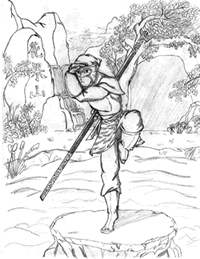
The Monkey King Holds His Enchanted Staff (Ruyi Jingu Bang)
Monkey King by Kevin Ng
Ruyi Jingu Bang (Chinese: 如意金箍棒; Pinyin: Rúyì Jīngū Bàng, literally meaning "As-you-will Golden-bound Cudgel"), or simply as Jingu Bang, is the poetic name of a magical weapon wielded by the Monkey King (Sun Wukong) in the classic Chinese novel Journey to the West. It is an iron rod whose size changes according to the whim of the user, once used by Da Yu to measure the depth of the flood waters destroying ancient China, which Wukong obtains from the undersea palace of Ao Guang, the Dragon King of the East Sea. When it is not in use, Wukong shrinks it to the size of a sewing needle and keeps it behind his ear.
Wu Shu Three Section Staff, 1 minutes and 46 seconds
Xing Yi Quan: Bibliography, Links, Resources, Quotes, Notes
Yang Tai Chi Staff. Taught by Jiang Jian-ye. This short staff form was created
by Sun Jixian, who was an indoor
student of Yang Banjou. This long form, suitable for persons at all skill levels,
is taught using two
instructional VHS videotapes featuring Shifu Jiang Jian-ye (1950-). Tape 1,
Part 1, teaches movements 1-34 of this form (VHS, 120 minutes). Tape 2, Part 2, teaches movements
35-68 of this form (VHS, 117 minutes). Produced by Shifu Jiang Jian-ye of the Capital District Tai Chi and Kung Fu
Association of New York, 29 West Dillenbeck Drive, Albany, NY 12203. These videotapes were produced in
2002. Website:
Jiang's
Tai Chi Videos.
Yang Style Tai Chi Chuan. Includes
numerous staff forms.
Zhang, Cane, Zhang Quan, Walking Stick, Short Staff: Information, Links, Resources, Styles
Return to the Index at the Top of This Webpage

Sierra Nevada, California
Rock Creek Basin, Mt. Starr (12,870')
Mike Garofalo, Hiker with Staff
Quotations
Staff Weapons
Facts, Legends, Lore, Literature
"The craft of cutting a walking stick
no doubt stretches back through time to when Man first walked on two legs. At first simple tools, they would quickly have come to be carved and decorated.
The known history of walking sticks however, begins much later in mid fifteenth century Europe when
sticks have been found ornately carved with historical events. The term 'cane' was introduced in Britain during
the reign of King Henry VIII to refer to sticks made of imported exotic woods. Today the word continues to
refer to the use of exotic woods as well as to mean a stick with a simple taper and without a curved
handle."
-
Phoenix Walking Stick Company
"Although the vast majority of
walkers never even think of using a walking staff, I unhesitatingly include
it among the foundations of the house that travels on my back. I still take
my staff along almost as automatically
as I take my pack. It is a third leg to me - and much more besides.
On smooth surfaces the staff helps maintain
an easy rhythm to may walking and gives me something to lean on when I stop to stand and stare. Over rough going of any kind, from tussocky grass to pockety rock, and also in a high wind,
it converts me when I am heavily laded from an insecure biped to a confident triped. ... It
may well be, too, that the staff also gives me
a false but subconsciously comforting feeling that I am not after all completely defenseless against attack by
such enemies as snakes, bears and men."
- Colin Fletcher, The Complete Walker III, 1984, p. 78
"In the ancient records of Chinese martial arts, the bo is discussed as
the first weapon taught to the Zen Buddhist disciples who studied at the Shaolin Temple. There are literary and pictorial
references to Bodhidharma carrying a bo on his journeys as he taught Zen Buddhism in the regions near the Shaolin
Temple. One account from a biography on Bodhidharma tells of his death in 528 AD from the poison of a
jealous monk. It is told that three years later his body was exhumed due to rumors he had been seen traveling in
the mountains of Central Asia.
Bodhidharma was said to carry a staff from which hung a single sandal. He had
stated he was on his way back to India. When the curious monks opened his tomb, all they found inside was a
single sandal. Ever since then Bodhidharma has been pictured carrying a staff from which hangs the missing
sandal."
-
Sa
Kwon
"In Chinese shamanism, a staff represents the power
of the universe. With a staff, a shaman had the power to pass on the universal knowledge to others. Later,
when teachers took over part of the shaman's job, they always taught with a small
staff in
their hands like a shaman."
- Master Zhongxian Wu, Vital Breath of the Dao, p. 106
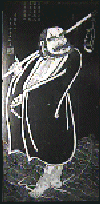
Legend of Bodhidharma's Single Sandal on His Staff
"The bokken (wooden staff-sword) was usually used as a training tool and
simulated the length of a sword. Miyamoto Musashi (author of the book of strategy "Go Rin No Sho" - "A Book of Five Rings") is considered by many to be the greatest swordsman in Japanese history. Many of his duels were
won using only a bokken.
He believed that fencing technique transcended the weapon used.
... Muso Gonnosuke was defeated by Miyamoto Musashi and allowed to live. He later developed the jo. The wooden jo
is around 4 feet long. This
length advantage over the sword allowed Muso Gonnosuke to defeat Miyamoto
Musashi in a rematch. He spared Musashi's life but that is the only known defeat suffered by Musashi. The
jo and bokken are two of the weapons used in aikido to commemorate that battle."
-
Gabrielle's
Staff Techniques By Donald Plunkett. 13K
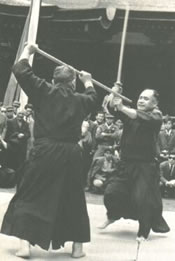
"Gonnosuke withdrew to a Shinto shrine at Mount Homan in Chikuzen province, (modern-day, Fukuoka Prefecture), where he would practice daily in perfecting his swordsmanship, praying and performing shinto purifying rituals for 37 days. It is also said, however, that he spent several years on the road studying other martial arts in various dojos until he ended up in the Shinto-shrine. After one of his regular (exhausting) training sessions he collapsed from fatigue and reputably had a vision of a divine being in the form of a child, saying to Gonnosuke: "know the solar plexus [of your opponent] with a round stick". In another version he had the vision in a dream late at night. He took it upon himself to create the jo deliberatly longer
than the average katana of the day, 128 cm as opposed to the swords total length of approx. 100 cm, and use that length to his advantage in a fight. Gonnosuke, drawing on his own considerable experience with the spear, longstaff, naginata and sword, also devised a set of five jo-techniques for use to counter and defeat a swordsman. Arguebly he also developed techniques to specifically hinder Musashi's trade-mark x-block.
As the tradition goes, Gonnosuke, now armed with the jo, would again face Musashi in a duel and defeat him through the use of the superior length of the jo to keep Musashisa'a swords out of range of Gonnosuke and thus hinder him from using the X-shaped technique effectively. Gonnosuke had Musashi at his mercy but let him live as a way of returning the favour granted in the first duel. Musashi, who was said to be impressed by how Gonnosuke had learned humility from his earlier arrogance and his new skills, made friends with Gonnosuke, and they would be each other companions during their travels.
The claim that Musashi was defeated, (at all), is still a matter of debate and is generally taken with a grain of salt."
- Muso Gonnosuke Katsuyoshi (circa 1600),
Wikipedia
Article
"I have no fitting gifts to give you at our parting ... But take these
staves. They may be of service to those
who walk or climb in the wild."
- J. R. R. Tolkien, The Two Towers

The
Hermit from the Marseilles Tarot
Diogenes with his his lamp and short staff searching for an honest man.
"Weapons such as the La Baton, a seven foot staff rod
approximately one inch diameter were commonly practice by Savate practitioners. It was particular famous among hillside and
farming communities of France and Spain. There is no particularly evidence on where the La Baton came from but
it has been suggested that this weapon came into existence by farmers and sheep herders tools such as
walking staffs and garden tools.
The more famous and popular weapon incorporated by Savate is the La Canne. A
1/2 inch diameter flexible stick approximately 36 inches in length. Savate combines traditional fencing
motions along with kicking techniques when wielding this dowel shape stick at the opponent. This weapon is
fast and flexible making it a fierce companion."
- Boxe Francaise Savate
"The peerless master moves with his group from place to place in the
mountains. His small band contains
two highly advanced American disciples. After Babaji has been in one
locality for some time he says,
'Dera danda uthao,' 'Let us lift our camp and staff.' He carries a
symbolic danda (bamboo staff). His words
are the signal for moving with his group instantaneously to another place.
He does not always employ
this method of astral travel; sometimes he goes on foot from peak to peak."
- Told by Swami Kebalananda to Paramhansa Yogananda in 1920, Autobiography
of a Yogi, p. 294.
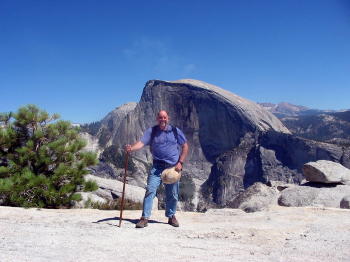
Yosemite National Park, California
Looking east from North Dome (7,450 feet) towards Half Dome
Mike Garofalo, Hiker with Staff
Chinese Chan Buddhist Master Shoushan held up a bamboo staff before a group and said, "If you call it a bamboo staff, you are clinging. If you do not call it a bamboo staff, you are ignoring. So tell me, what do you call it?" - Wumenquan, # 43.
"The title of Monkey Pole, or Monkey King Staff, is a curious reference
to the legendary Monkey King character from Chinese mythology. The Monkey King is a mythical figure whose exploits are
described in the 400-year-old Chinese classic Journey to the West.
The Money King was an immortal, a
god-like creature who was characterized by mischievous acts and defiance of the ruler of Heaven. His weapon of choice
was a great rod of iron that he had stolen from the Dragon King of the Eastern Sea. He bound the ends of his
staff with gold and engraved it with the words "Gold-bound Wand of my Desires."
Imbued in the staff itself were magic powers that allowed it to change size from the finest of needles to a length that could span the
distance between Heaven and Earth.
The mercurial nature of the Monkey King's staff is said to represent the
flexible nature of the Buddhist doctrine and its ability to be applied to all situations great and small."
-
Hung Chur Kwun - The Hung
Gar Monkey Pole Set
"Yea, though I walk through the valley of the shadow of death,
I will fear no
evil,
For thou art with me;
Thy rod and thy staff, they comfort me."
- Bible, Old Testament, Psalm, 23:4
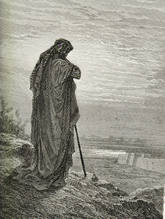
"The shepherd's crook is a reminder of Jesus, the
Good Shepherd. It may also be used as a symbol of King David or of the shepherds who visited the baby Jesus in the manger.
A highly
ornamented crook is called a "crosier" (French for "cross-bearer"), and is a symbol of ecclesiastical
authority carried by a bishop or abbot."
-
Symbols
in Christian Art
Bible: John 10:11,
Good
Shepherd chapter.
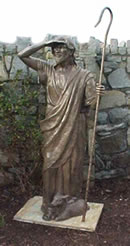
Good Shepherd Statue in Holyhead, Wales, UK
"The walking stick or "cane" has long held a place in man's
history, its roots leading back to the "big stick" wielded by prehistoric man as a weapon of both self-defense and
aggression. Civilized man carried on the tradition. Ancient Egyptians and Greeks represented their rulers and gods
carrying staffs which symbolized authority. These staffs became the scepters of kings during the Middle
Ages. The staff's role as an aid to travel was exemplified in the hands of pilgrims and shepherds. These wooden
staffs usually were heavy sticks about 5 feet long. Very often the tops of the sticks held secret
compartments for carrying valuables or for smuggling contraband. Records show that silkworm eggs were smuggled into
Europe via a hollow staff. The first tulip bulb introduced into Holland also was reported to have
made a similar entrance."
-
The
Walking Stick in History, Vigo County Historical Society
Chinese Chan Buddhist Master Baqiao said to a group, "If you have a
staff, I will give you a staff; if you have no staff, I will take your staff away."
Wumen added, "It helps you across a river where bridges are out, and gets
you back to the village when there is no moon. If your call it a staff, you go
to hell
fast as an arrow."
Zen Master Wuzhou added, "Baqiao raised his staff, startling all creation:
shrimp may fly past the heavens, but eyebrows are still above eyes."
- "Unlocking the Zen Koan: A New Translation of the Zen Classic
Wumenguan." Translated by Thomas Cleary, 1993, 1997, p.
195.
"Monkey
King",or known to the Chinese as "Journey to West",written by Wu
Ch'eng-en(1500?-1582),a scholar-official, is one of the renowned classical
Chinese novels about an allegorical rendition of the journey, mingled with
Chinese fables, fairy tables, legends,superstitions, popuar beliefs, monster
stories as well as whatever the author could find in the Taoist and Buddhist
religions. It was based on a true story of a famous Chinese monk, Xuan Zang
(602-664). After years of trials and tribulations, he travelled on foot to what
is today India, the birthplace of
Buddhism, to seek for the Sutra, the Buddhist holy book. When he returned to
China ,or the Great Tang as was called that time, he started to translate the
sutras into Chinese, thus making a great contribution to the development of
Buddhism in China.
Monkey King is an indeed rebellious extraordinary being, born out of a rock,
fertilized by the grace of Heaven, Being extremely smart and capable, he learned
all the magic tricks and gongfu from a master Taoist,being able to transform
himself into seventy-two different images such as a tree, a bird, a beast of
prey or a bug as small as a mosquito so as to sneak into an enemy's belly to
fight him inside or out. Using clouds as a vehicle he can travel 180,000 miles a
single somersault and a huge iron bar that supposedly serves as ballast of the
seas and can expand or shrink at its owner's command as his favorite weapon in
his later feats. He claims to be the king in defiance of the only authority over
heaven, the seas, the earth and the subterranean world -- Yu Huang Da Di, or the
"Great Emperor of Jade" in Chinese. That act of high treason, coupled with
complaints from the masters of the four seas and the hell, invites the
relentless scourge of the Heavenly army.After many showdowns,the emperor had to
offer the monkey an official title to appease him. Enraged he revolted, fighting
all his way back earth to resume his own claim as a king after learning that the
position he held was nothing but a stable keeper. Eventually, the heavenly
army subdued him, only after many a battle, with the help of all the god
warriors. However,Having a bronze head and iron shoulders, all methods of
execution failed and the monkey dulled many a sword inflicted upon him. As a
last resort, the emperor commanded that he be burned in the furnace where his
Taoist minister Tai Shang Lao Jun refines his pills of immortality. Instead of
killing him, the fire and smoke added to the monkey a pair of firy golden
crystal eyes that can see through what people normally can not. He fought his
way down again. Finally, under Buddha's help,the monkey was suppressed under a
great mountain known as the Mount of Five Fingers and he could not move. Only
five hundred years later, there came to his rescuer ,the Tang Monk, Xuan Zang,
whom we mentioned at the beginning of the story. The
Monkey King become the desciple of the monk and escort him with Buddha's
arrange to insure that he could make for the West to get the sutras, along with
two other desciples they later came across, (actually also arranged by the
Buddha). One is the humorous and not uncourageous pig transgressed from a
heavenly general for his crime of assaulting a fairy, and the other a used-to-be
sea monster. There started the four's stormy journey west which was packed with
actions and adventures that brought into full play the puissance of the monks'
disciples, the
Monkey King in particular. The story of Journey to the West is divided into
three parts: (1) an early history of the Monkey spirit; (2) pseudo-historical
account of Tripitaka's family and life before his trip to fetch the sutras in
the Western Heaven; (3)the main story, consisting of 81 dangers and calamities
encountered by Tripitaka and his three animal spirit disciples - Monkey, Pigsy,
and Sandy .The average readers are facsinated with the
Monkey King,all prowess and wisdom, while many critics agree that the
protagonist embodies what the author tried to convey to his readers: a
rebellious spirit against the then untouchable feudal rulers.Anyway,with its
attracted story and its special feature of
language,the novel will certainly stay."
- Adapted from HaiWang
Yuan, Western Kentucky University
"Devi prachanda dora danda daitya
darpa winashine
Roopam dehi jayam dehi
Yasho dehi dwisho jahi.
"Oh Goddess, with your great staff you have
destroyed the demons of egoism and thought.
Grant me freedom, victory, fame and destroy
all hostility."
- Devi Puja (Worship of the Goddess)
Krishna Das,
Pilgrim Heart
"The staff makes the body a little lighter,
If used the way it's supposed to be used,
And makes moving through the forest brighter
If skill and technique is not abused.
"Three points of contact" is the
defensive shield
That can cut down on many a fall,
When a stick, limb, or vine is suddenly revealed
And a spill down a hill might call.
When heavy undergrowth does appear
And penetration is the thing to do,
The staff is the perfect tool to have near
To create a path you can go through."
- James Ebb Huggins, Jr.,
The
Walking Staff
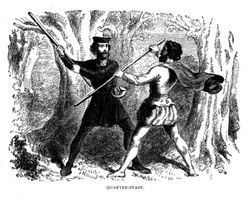
Old English Sports and Pastimes by P. H. Ditchfield
"Walk softly and carry a big stick."
- Attributed to U.S. President, Theodore Roosevelt
"The correct use of the bo (sai, tonfa, kama, naginata, sword) can
produce a stimulating and practical means of "extension" training. It offers a means of martial arts training and discipline. Weapons training teaches the meaning of control, timing, distance, and flexibility as one unit. The
practitioner is required to possess speed, coordination, strength, and endurance in utilizing the respective weapons."
-
History of the
Bo Staff
Donatello, The Thinker, Teenage Mutant Ninja Turtle, Bo Weapon Master.
"Shaolin Kung Fu is famous for its staff, which has become
an unofficial symbol of Shaolin weapons. Philosophically, the Shaolin staff manifests what Shaolin Kung Fu stands for: simple yet versatile, hardy
yet compassionate. It is difficult to find a weapon simpler than a staff,
yet the techniques for other weapons, like the spear, halberd, mace, battle axe, scimitar, sword or dagger, are all
incorporated in staff training. A staff, like a Shaolin disciple, is made for all seasons. And though it
is hardy, its combat application
is a hallmark of compassion, since it is devoid of any sharp or pointed parts
which can maim or kill an
opponent."
- Wong Kiew Kit, The Complete Book of Tai Chi Chuan, 1996, p.
280.
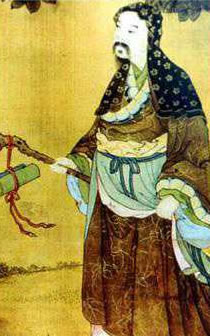
"The short staff [a straight staff of some 7 feet in
length] is most commonly the best weapon of all others, although other weapons may be more offensive, and especially against
many weapons together, by reason of his nimbleness and swift motions, and is not
much inferior to the Forest bill [a polearm similar in some ways to the yinyuedao, though spikier]"
- George Silver, "Paradoxes of Defence", 1599 [Remarks] by
Peregrine Dace
"The Chinese word gun (棍
pinyin gùn) refers to a long Chinese staff weapon. It is known as one of the four major weapons, along with the spear, saber, and the sword, called in this group "The Grandfather of all Weapons".
There are various kinds of gun and these include (from olden days): Monkey Staff (猴棍), Biangan (鞭杆), Mad Demon Staff (瘋魔棍), Tianqi Staff (天齊棍), Staff of Five Tigers and Goat Herds (五虎群羊棍), Nunchaku (二節棍), Taiji Staff of Thirteen (太極十三杆), Taiji Quarterstaff (太極大杆), Taiji Staff (太極棍), Staff of Eight Trigrams and Seven Stars (八卦七星竿), Staff of Eight Fairies (八仙棍), Flail (槤枷).
The types of gun normally used nowadays for exercises and competitions are the bailangan (白栏杆) and the nangun (南棍)."
-
Wikipedia Gun
(Staff)
"The Magical Staff, which is also called "
Staff" or " Nine-Segment Staff"2, is a kind of Magical Instrument frequently
used in Daoist rituals of Fasts
and Offerings. The staff is a tool for helping old people to stand up and walk.
In ancient China, the staff was also taken to be the symbol of royal
or military power, and was also an instrument of torture used for punishing
prisoners. In the biographies of spirits published after the Eastern Han
dynasty, the staff was taken to be a substitute for the human body after his
Deliverance from the Corpse. In the Southern and Northern Dynasties, the
staff was also a symbol of power. The Essential Secrets of the Most High by
Yuwen Yong, emperor Wu of the Northern Zhou dynasty, contains a "Chapter on
Staffs", which says that the Primeval Lord of Heaven has a divine Staff.
"It is made of seven-segment supreme Yang bamboo from the Numinous Mountain.
The highest and the lowest segments of the bamboo are hollow, which corresponds
to Heaven and Earth. However, most Daoist scriptures published afterwards say
that the magical staff has nine segments. The Imperial Encyclopedia of the
Taiping Era cites the Original Register of Tortoise Mountain, saying, "in the
third month in winter, the Jade Lads of the Three Heavens transform into an old
man holding a nine-segment gold staff". The use of the Magical Staff in
Daoist rituals of Fasts and Offerings probably started after the Liu Song regime
of the Southern Song dynasty."
- Chen Yaoting.
Magical Staffs in Taoist Rituals
"Speak and you get Nanten's staff,
Do not speak and you still get Nanten's staff."
- Zen Koan
Take a look at the Zen painting of Nanten's staff by
Nakahara
Nantembo (1839-1925)
Zen Masters would pound their ceremonial staff on the ground
when making a point
during a lecture or discussion.
"The staff (Danda) is symbolic for the spine supporting the body.
Since man's emergence
for the animal kingdom he has walked erect. The levels of consciousness
are in the spine
where the life force is dominant. The base of the spine [Muladhara Cakra]
is the place where the Kundalini Energy (Divine Coiled Serpent) is located. Khatvanga (Staff with Skull on Top) is symbolic of a pure or empty mind, one
which is free
from preconceived ideas which block the way for new perceptions, particularly
Divine
insight, that is, insight by intuition during meditation, reflection or
quietness. In contrast
to the perconceived ideas stands true knowledge, which is knowing from
personal experience. Information is often mistaken for knowledge. The skull
is mounted on a staff (the spine). The Kundalini Energy can then rise in the
Sahasrara. The flow of the Divine energy through the staff or spine, into the empty skull, the mind free of
preconceived
ideas, is an experience that shakes one's whole foundation."
- Kundalini: Yoga for the West. By Swami Sivananda
Radha. Timeless Books, 1978. p.41
Zen Master Hakuin (1686-1768) painted a Dragon Staff with horsehair whisk
attached.
He would give this painting to his lay students who passed the Zen koan,
"What is the sound of one hand clapping."
"The jo can be used to strike like a sword, sweep like a naginata,
thrust like a spear (yari). Its two ends can be used, unlike the single point of a sword, and its ma-ai (fighting distance) can
be varied according to the hand grip you take. Because of its speed and changeable ma-ai, it is a formidable
weapon."
-
Muso Shindo-Ryu Jodo
"Wukong , The Monkey King, eventually
obtained the "As-you-will Golden-banded
Cudgel", known as
Ruyi Jingu Bang, which he could shrink to the size of a needle and keep
inside his ear. The staff could also be expanded to be as high as Heaven. It was
originally a stick for measuring sea water depth by
Dà-Yǔ in his
flood control and treatment efforts, hence its ability to vary its shape and
length. It weighed 13,500
jin (6,750 kilograms), and could multiply, transform, and act
intelligently. After Da-Yu left, it remained in the sea and became the "Pillar
holding down the sea", an unmovable treasure of the undersea palace of the
"Eastern-sea
dragon-king",
Ao Guang.
One of Wukong's senior advisors had told him to seek out the dragon-kin in order
to get a powerful weapon befitting his skill. There in the dragon palace, he
tried out several kinds of ancient heavenly weapons, many of which bent or
completely broke as he wielded them. Ao Guang's wife then suggested the "pillar"
(thinking he would not be able to lift it). But when Wukong neared the pillar,
it began to glow, signifying that the monkey king was its true owner. It
obediently listened to his commands and shrank to a manageable size so Wukong
could wield it effectively. This not only awed the dragon and his wife, it also
threw the sea into confusion, since the monkey king had removed the only thing
controlling the ebb and flow of the ocean's tides. In addition to the magic
staff, Wukong also forced Ao Guang to give him other magical gifts; including
golden chain mail, a phoenix-feather cap, and cloud-walking boots..."
- Sun Wukong, The Monkey
King, Wikipedia
The Song of the Staff
By Milarepa
"Listen, my dear, inquisitive patron!
Do you know who I am?
I am the Yogi, Milarepa,
Who follows the ascetic way;
I am a yogi, great in strength and perseverance,
Who has no limitation.
The staff in my hand
Grew on a huge rock.
It was cut by a sickle and became
A companion of wild stags.
It came from Nepal, in the South;
From it I hung the Mahayana Sutras;
I take it with me to the marketplace;
It was offered to me by a faithful follower.
This is the story of my walking staff.
If you do not understand my meaning,
Listen then with great care:
The stout end, cut from near the root,
Symbolizes being "cut off" from Samsara.
The thin end, cut from near the top,
Symbolizes the "cutting off of all doubts and confusions.
It is two cubits long and represents
The twin qualities of a Buddhist.
Of good quality and pliant, it is like
The original Mind-Essence - good and sound.
The varnish, of a pleasant brown, is like
The great harmony of the "Original Mind Nature."
Straight and supple, it symbolizes
Unmistaken practice and devotion.
The tiny grooves you see, represent
the Perfection of the Bodhi-Path,
The four joints in the cane
Are the For Infinite Wishes,
The three knots symbolize
the Three Bodies of the Buddha.
It never changes color. This represents
The immutable reality of the Root Principle.
Its head, curved and covered, displays
The "beyond-playwords" nature of reality'
Its white glittering appearance shows
The Dharmakaya - immaculate and pure.
The hollows symbolize the void nature of all beings,
The spots are a symbol of the sole Tig Le.
The scattered black marks indicate
that Tibetan yogis and Repas
Have few disturbing thoughts.
This cane most excellent represents
My devotion and practice in compliance with the Dharma.
Its elegance and loveliness displays
My disciples' sincerity and faith.
The iron ferrrule on the tip conveys
The perseverance of yogis in the hermitage.
The handle, wrapped with copper, represents
the mastery and attraction of Dakinis.
The nail attached to the tip displays
The bravery and diligence of yogis;
The hanging brass ring represents
The increase of inner merits.
The ornament of Sha Bran hanging down
Is the flexible understanding of the yogi.
The thong of two twisted ropes represents
The entering of the Two-in-One Path;
The Mother-and-Son thongs intermingling,
The meeting with the Mother of the Three Bodies.
The bone-ornaments hanging on the staff
Mean many travels for the yogi.
The flint and bellow signify
That all he sees and meets
Are the yogi's friends.
The white shell hanging on the staff
Means that I shall turn the Wheel of Dharma.
The rag of leather symbolizes
The yogi's attitude, without fear or shame.
The mirror hanging on the staff
Is the Enlightenment that shines within.
The sharp knife indicates
That the pain of passions will be cut.
The stone-crystal symbolizes
The purifying of defiled habitual thoughts.
The ivory chain hanging on the staff
Is the Chain-of-Regard between Guru and disciple.
The set of bells symbolizes
My widespread reputation;
The woolen cords of read and white,
That my disciples will be numerous.
The handsome staff that now I hold
Is the means and symbol of the conquest over evil beings.
Patron, you ask me for the meaning of this staff;
This proves you have sincerity and faith.
This present meeting witnesses
Our pure wishes in a former life.
For mankind and Devas, conceivers of all symbols,
I have sung this "Song of the White Staff."
Revere then and appreciate its Dharma teaching.
Dear patron, I hope your practice Dharma
And win happiness supreme."
- Milarepa, "The Song of the
Staff" from
"The Hundred Thousand Songs of Milarepa."
Translated by C. C. Chang, 1962, 1989, Volume One, p. 190-199
The spear (ch'iang/qiang) is as ancient as China. Not only is it considered to be the oldest military weapon in China, the spear was originally developed as a horse soldier's weapon. Before 400 B.C., foot soldiers used either a nine foot spear or an eighteen foot spear. These spears combined a thrusting point with a hooking or slicing blade.
As a footnote, there are other types of spears-snake-head pattern spear, single hook spear (hooking fish spear), and double hook spear (hooking fish spear). (This particular topic will be discussed in a later article on Chinese weaponry.)
Unlike the spear that is used in other parts of the world, the Chinese spear was never meant to be thrown. Instead, a specialized set of techniques was developed that strongly resembled the single-headed staff techniques. Staffs of various lengths derived spillover value from some of the spear tactics, although they have complete systems of their own.
"When you use the spear you must
judge where you are going to hit and focus your eyes on the target. Focus your
eyes on your opponent's head, torso, or foot. When the spear is thrust, you
should coordinate the weapon with your mind, hands, and feet. Your spear should
shoot like a dragon rising from the sea. The motion must be able to surround the
opponent body. With that action, you will be able to hit him."
-
Spear -
Chinese. King of Chinese Weapons
"So I took the bright red stick and at the center of the nation's hoop I
thrust it in the earth.
As it touched the earth it leaped mightily in my hand and was a waga chun,
the rustling
tree [cottonwood], very tall and full of leafy branches and of all birds
singing. And beneath
it all the animals were mingling with the people like relatives and making happy
cries.
The women raised their tremolo of joy, and the men shouted all together;
"Here we shall
raise our children, and be as little chickens under the mother sheo's
[prairie hen] wing.
Then I heard the white wind blowing gently through the tree and singing there,
and from the east the sacred pipe came flying on its eagle wings, and stopped before me there
beneath
the tree, spreading deep peace around it."
- Black Elk Speaks, 1932, p. 29, as told to John G.
Neihardt.
Disclaimer
Warning: Practicing with Staff Weapons Can Be a
Dangerous Activity for Adults

Robin Hood and Little John Fighting with Staff
Weapons on the Bridge
"Little John gave Robin a knock on the crown,
Which caused the blood to appear,
Then Robin enraged, more fiercely engaged,
And followed with blows more severe.
So thick and fast did he lay it on him,
With a passionate fury and ire,
At every stroke he made him to smoke,
As if he had been all on fire."
Stories of Robin Hood Told to the Children by H. E.
Marshall
"A bo (棒) is a long stick usually made out of wood or bamboo, but sometimes it is made of metal for some extra strength. A full-size bo is also sometimes called rokushakubo (六尺棒).
This name derives from the Japanese words roku (meaning "six"), shaku (a Japanese measurement equivalent to 30.3 centimeters, or just under 1 foot) and bo (kanji, Chinese character meaning "staff"). Thus, rokushakubo refers to a staff about 6 shaku (181.8 cm, about 6 ft.) long. Other types of bo range from heavy to light, from rigid to highly flexible, and from simply a piece of wood picked up off the side of the road to ornately decorated works of art.
The martial art of wielding the bo is bojutsu. The basic purpose of the bo is to increase the force delivered in a strike through leverage. A relatively small motion made at the point of contact between the user and the bo results in a much faster, more forceful motion made by the tip of the bo farthest from the user. This enables long-range crushing and sweeping strikes. The bo may also be thrust at an opponent, basically allowing for a punch from long distance. It can also be used for joint-locks, thrustings of the bo that immobilize a target joint, which are used to non-fatally subdue an opponent. The bo is a weapon mainly used for self-defense, and can be used to execute several blocks and parries as well. Martial arts techniques, such as kicks and blocks, are also often combined with the weapon techniques when practicing this martial art to enhance its effectiveness.
In styles such as Yamani Ryu or Kenshin Ryu, many of the strikes are the same as those used for Yari (spear) or Naginata (Japanese polearm)."
-
Bo Weapon - Wikipedia
Article
"The staff is the oldest and most
primitive weapon ever used by humans. Over thousands of years of use, the
efficient techniques have been developed to enhance a fighter's barehand
skills. It is called the grandfather of all weapons though made of wood, the
staff can fracture bones and break the blade of a sword. The Shaolin Monks are
said to be the greatest masters of the staff. Once mastered, the staff forms
a strong foundation for learning other long weapons and more advanced weapons.
The qiang, spear, is known as the king of all weapons. It has a long
shaft and stab, entangle, and cut an opponent. The attacks are usually more
linear, taking advantage of the stabbing of the spearhead, while the staff has
more sweeping movements."
-
Wushu Xtreme Team
"Spear (Greek: λόγχη, Latin: hasta, German: Speer, Lanze, French: lance, Spanish: lanza, Italian: lancia) is the name of a pole weapon used for hunting and war, consisting of a shaft, usually of wood, with a sharpened head. The head may be simply the sharpened end of the shaft itself, as is the case with bamboo spears, or it may be of another material fastened to the shaft. The most common design is of a metal spearhead, shaped like a triangle or a leaf.
Spears were arguably one of the most common personal weapons from the late Bronze Age until the advent of firearms. They may be seen as the ancestor of such weapons as the lance, the halberd, the naginata and the pike. One of the earliest weapons fashioned by human beings and their ancestors, it is still used for hunting and fishing, and its influences can still be seen in contemporary military arsenals as the rifle-mounted bayonet.
Spears can be used as both melee and ballistic weapons. Spears used primarily
for thrusting tend to have heavier and sturdier designs than those intended
exclusively for throwing. Two of the most noted throwing spears are the
javelin thrown by the ancient Greeks and the
pilum used by the
Romans."
- Spear - Wikipedia
"The most popular Shaolin Kung Fu 'tool' was the staff.
A long stick that had a variety
of uses and purposes. It is a multi-purpose implement that can be used for many
things
other than self defense. A staff is used as a walking stick, to carry loads on
your back,
carry and transport two water buckets, as a lever, tent pole, writing implement
(in the
sand) and many more. This is also the weapon that almost all Chinese martial
arts
consider to be "The Father of all Weapons". It is also highly effective and
recommended
for all martial artists to learn.
There were of course many staff types as there are different woods, people and
ways
of using. But in general most staffed weapons can be but into 5 specific sizes
(general
lengths - all Shaolin weapon dimensions were measured in 'natural' measurements
relating to the user):
Dragon Staff (app 1½ person lengths or 8 to 9 foot)
Shaolin Staff (app 1 person length or 5½ to 6½ foot [also Rat Tail Staff, very
flexible, Bai La Wood])
Carry Staff (app ¾ person length)
Cudgel or Walking Stick (app half person length and very stout)
Flute, Ruler (app fore arm to fore arm and hand length)"
- Chinese Weapons
"It is said in Chinese history and martial traditions that all
staff forms came from five styles, those being:
1. Tai Tsu Kun, (First Emperor's staff techniques) created by Chao K'uang yin of
the Sung Dynasty.
2. Ng Yang Ba Gwa Gwun, (Fifth Brother Eight Diagram staff techniques), created
by Fifth Brother Yang.
3. Wu Sung Qwan, (Wu Sung staff techniques), created by Wu Sung of the Sung
Dynasty, which is also known as the "Travelers Staff".
4. T'u Hsing Sun (Earth Traveler staff techniques) from the Chou Dynasty.
5. Sun, The Traveler, who is depicted in the famous Chinese novel "Western
Pilgrimage", who was known for the monkey staff techniques, and also for the six
and half point techniques."
-
History of the Five Famous Staff Forms of China
"A weapon of Goa'uld design. Several feet in length, its head divides into four parts when activated, releasing powerful bolts of plasma energy. The weapon is powered by a small, green container of liquid naquadah. It is generally considered to be a weapon of terror, since its ability to accurately target a moving object, let alone a motionless one, is less reliable than some human weapons that have pin-point accuracy. The staff weapon is, before the zat gun, the weapon of choice for Jaffa, who train to be proficient with both aiming and firing the weapon, and with using it in hand-to-hand combat. Young warriors are taught personal combat techniques with a wooden training staff, shaped to resemble a staff weapon."
-
Stargate
Omnipedia, Stargate is a popular science fiction program
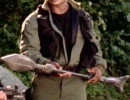
"In the first Star Wars film, lightsabers appeared to cast shadows, something we wouldn't expect from a beam of light like a laser. This may have been due to the fact that they were filmed with solid staffs which were later redone by special effects to look like beams of light.
Now in the age of advanced computer graphics such clumsy expediencies as solid shafts on set can be dispensed with, but lightsaber shadows have been firmly established in the iconography of the weapon. That's to be expected. Designing a sword analog calls for some very unlaser-like characteristics."
-
Lightsabers Are
Cutting Edge Technology

Return to the Index at the Top of This Webpage
![]()
Equipment Notes
Distributors, Suppliers, Manufacturers, Vendors
The Jo staff, or short staff, is about 50" long and 1" to 1.25" in diameter. It is made of oak, ash, rattan, wax wood, bamboo, fiberglass or aluminum. It has rounded ends. Some have one or both ends tapered. Some have elaborate carvings or painted designs on the staff. The short staff comes in a variety of sizes: 48", 50".
The Tai Chi Chuan short staff should be about 13 hands long. Measure along the staff by placing one hand around the staff, then your other hand gently touching your first hand. Count up 13 hands - that is the right sized staff length for a Tai Chi Chuan short staff. A child will have a shorter staff than a tall, large, full grown man. Using this formula, since I am 76.5" tall, my short staff would be around 52.5" long, a ratio of 1" in height to .6862" in staff. My hiking short staff is 49.5" long. I use a 50" long, 1.25" in diameter, non-tapered, flat ended, stout white oak short staff for my practice.
As with the Tai Chi Sword or Saber, those using a short staff might fix a colorful silk scarf, colorful ribbons, woven leather string or other objects at one end of their short or long staff. The short staff may also be elaborately carved or painted or inlaid with precious stones or other power objects.
The Bo staff, medium staff, gun, is about 72" long and 1.25" in diameter. Bo's are made of oak, ash, rattan, bamboo, wax wood, fiberglass, or aluminum. Bo's often have flat ends. Some Bo's have one or both ends tapered. Some have elaborate carvings or painted designs on the staff. I use a 72" long, 1.25" inch in diameter, non-tapered, flat ended, stout red oak staff for my practice.
Related Terms: staff, stave, jo, bo, gun, cudgel, cane, pole, stick, walking stick, shillelagh, baton, rod, club, short staff, bat, mace, spear, scepter, crook, crosier, wizard's staff, shepherd's staff.
"The Chinese word gun (棍
pinyin gùn) refers to a long Chinese staff weapon. It is known as one of the four major weapons, along with the spear, saber, and the sword, called in this group "The Grandfather of all Weapons".
There are various kinds of gun and these include (from olden days): Monkey Staff (猴棍), Biangan (鞭杆), Mad Demon Staff (瘋魔棍), Tianqi Staff (天齊棍), Staff of Five Tigers and Goat Herds (五虎群羊棍), Nunchaku (二節棍), Taiji Staff of Thirteen (太極十三杆), Taiji Quarterstaff (太極大杆), Taiji Staff (太極棍), Staff of Eight Trigrams and Seven Stars (八卦七星竿), Staff of Eight Fairies (八仙棍), Flail (槤枷).
The types of gun normally used nowadays for exercises and competitions are the bailangan (白栏杆) and the nangun (
Related Terms (Wikipedia
Pole Weapons): Ahlspiess, Arbir, Barchi (lance), Bardiche, Bec de Corbin,
Bill, Bisento, Bo. Brandistock, Bâton français, Chacing staff, Dagger-axe,
Danish axe, Falx, Fauchard,
Flax, Footman's lance, Glaive, Guan dao, Guisarme, Gun (staff), Halberd, Hanbo, Hasta (spear).
Horseman's pick, Ji (halberd), Kontos, Lance, Lochaber axe, Lucerne hammer, Man catcher,
Mattock,
Maul, Military fork, Nagamaki, Naginata, Otsuchi, Ox tongue, Partisan, Pike, Plançon a picot,
Pollaxe,
Qiang (spear), Quarterstaff, Ranseur, Rhomphaia, Roundhead, Sarissa, Soliferrum,
Spear, Spetum,
Spontoon, Tabar Zin, Taiaha, Tanjo, Tepoztopilli, Tetsubo, Trident, Voulge, War hammer,
War scythe.
" Ming Dynastry (1368-1644): From the 8th to the 15th centuries, no extant source documents Shaolin participation in combat; then suddenly, the 16th and 17th centuries see at least forty extant sources attest that, not only did monks of Shaolin practice martial arts, but martial practice had become such an integral element of Shaolin monastic life that the monks felt the need to justify it by creating new Buddhist lore.[4]References to Shaolin martial arts appear in various literary genres of the late Ming: the epitaphs of Shaolin warrior monks, martial-arts manuals, military encyclopedias, historical writings, travelogues, fiction, and even poetry.[4]
These sources, in contrast to those from the Tang Dynasty period, refer to Shaolin methods of combat unarmed, with the spear, and with the weapon that was the forte of the Shaolin monks and for which they had become famous—the staff.[4][3] By the mid-16th century military experts from all over Ming China were travelling to Shaolin to study its fighting techniques.
Around 1560 Yú Dàyóu travelled to Shaolin Monastery to see for himself its monks' fighting techniques, but found them disappointing. Yú returned to the south with two monks, Zongqing and Pucong, whom he taught the use of the staff over the next three years, after which Zongqing and Pucong returned to Shaolin Monastery and taught their brother monks what they had learned. Martial arts historian Tang Hao traced the Shaolin staff style Five Tigers Interception to Yú's teachings.
The earliest extant manual on Shaolin Kung Fu, the Exposition of the Original Shaolin Staff Method[6] was written around 1610 and published in 1621 from what its author Chéng Zōngyóu learned during a more than ten year stay at the monastery.
Conditions of lawlessness in
Henan—where the
Shaolin Monastery is located—and surrounding provinces during the late
Ming
Dynasty and all of the
Qing
Dynasty contributed to the development of martial arts. Meir Shahar lists
the martial arts
T'ai Chi Ch'üan, Chang Family Boxing,
Bāguàquán,
Xíngyìquán
and Bājíquán
as originating from this region and this time period."
- Shaolin
Kung Fu - Wikipedia
Disclaimer
Warning: Practicing with Staff Weapons Can Be a
Dangerous Activity for Adults
Return to the Index at the Top of This Webpage
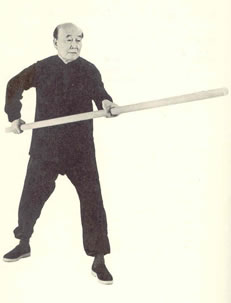
Master T. T. Liang (1900-2002)
T’ai
Chi Ch’uan For Health and Self-Defense, 1974
![]()
My Own Staff Practices
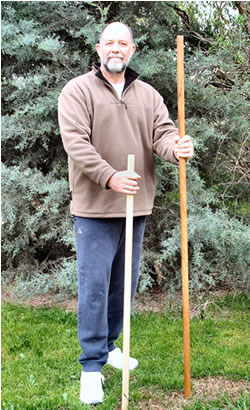
Mike Garofalo
Valley Spirit Taijiaun
Red Bluff, California
March 2007
I practice with two staff weapons:
White Oak Staff, 50" long x 1.25" diameter, from
WLE
Red Oak Staff, 72" long x 1.25" diameter, from WLE
Currently, I am practicing the Taoist Eight Immortals Cane Form as demonstrated by Master Jesse Tsao.
Return to the Index at the Top of This Webpage
Staff Forms - A Listing
Bailangan (Simplified Chinese: 白栏杆; Traditional Chinese: 白欄杆; Hanyu Pinyin: bái lángān). A type of Chinese staff weapon used in competition and practice.
Ch'en's Staff. Chinese.
Coiling Dragon Staff. Chinese.
Double Headed Staff. Choy Li Fut. Chinese.
Earth Traveler Staff Techniques (T'u Hsing Sun). Chinese.
Eight Fairies Staff (Chinese: 八仙棍; Hanyu Pinyin: bāxiān gùn). Chinese.
Eight Immortals Taiji Cane or Staff
Eight Trigrams and Seven Stars Staff (Chinese: 八卦七星竿棍; Hanyu Pinyin: bāguà qīxīng gān). Chinese.
Eyebrow Level Staff (Chai Mei Kwun). Chinese.
Fifth Yang Brother Eight Diagram Pole (Ng Yang Ba Gwa Gwun). Chinese.
First Emperor's Staff Techniques (Tai Tsu Kun). Chinese.
Five Element Staff. Chinese.
Five Tigers and Goat Herds (Chinese: 五虎群羊棍; Hanyu Pinyin: wǔ hǔ qún yáng gùn); Five Tigers Stalk the Sheep; Staff of Five Tigers and Goat Herders (五虎群羊棍); Five Tigers Swarming Sheep. Five Tigers and Herds of Sheep. Chen Taijiquan, Shaolin. Chinese.
Flail (Simplified Chinese: 梿枷; Traditional Chinese: 槤枷; Hanyu Pinyin: liánjiā). Chinese.
Flowing Water Staff. Chinese.
Gun: Staff (Chinese: 棍; Hanyu Pinyin: gùn) A staff's length is from the floor to about your eyebrow height.
Heavenly Staff. Chinese.
Left Hand Plum Blossom Spear (Jow Sao Moi Fa Churn). Chinese.
Left Sided Staff. Hung Fut. Chinese.
Lohan Staff Techniques (Lohan Gwun Faht). China.
Mad Demon Staff (Simplified Chinese: 疯魔棍; Traditional Chinese: 瘋魔棍; Hanyu Pinyin: fēngmó gùn)
Mad Devils Left Hand Staff Form. Hung Fot. Chinese.
Nangun (Chinese: 南棍; Hanyu Pinyin: nángùn).Biangan Staff (Chinese: 鞭杆棍; Hanyu Pinyin: biāngān). A type of Chinese staff weapon used in competition and practice.
Ng Long Bat Kwa Kwun. Choy Lee Fut, Hung Gar, Southern Shaolin. Chinese.
Monkey Staff (Hao Ji Kwun). Hung Gar. Chinese. Monkey Staff (Chinese: 猴棍; Hanyu Pinyin: hóugùn)
Monkey Stick (Hun Je Pang). Hung Ga. Chinese.
Nunchaku Staff (Simplified Chinese: 二节棍; Traditional Chinese: 雙節棍; Hanyu Pinyin: èrjié gùn; literally "Two Section Staff"). Chinese
Pa-Feng Staff. Chinese.
Pear Flower Spear (Lee Fa Cheung). Chinese.
Red Sparrow Staff. Chinese.
Single Combined With Double Head Staff (Seurng Gap Dan Kwun). Choy Lay Fut. Chinese.
Six and a Half Points Staff (Luk Dim Boon Kwun). Wing Chun. Chinese.
Shepard's Staff (Quan Yeung Kwun). Chinese. See also Five Tigers Stalk the Sheep.
Staff (Chinese: 棍; Hanyu Pinyin: gùn) A staff's length is from the floor to about your eyebrow height.
Swimming Dragon Staff. Chinese.
Taiji Quarterstaff (Simplified Chinese: 太极大秆; Traditional Chinese: 太極大杆; Hanyu Pinyin: tàijí dà gǎn). Chinese.
Taiji Staff (Simplified Chinese: 太极棍; Traditional Chinese: 太極棍; Hanyu Pinyin: tàijí gùn)
Taiji Staff of Thirteen (Simplified Chinese: 太极十三秆; Traditional Chinese: 太極十三杆; Hanyu Pinyin: tàijí shísān gǎn). Chinese.
Thirteen Jo Kata. Aikido. Japanese.
Tianqi Staff (Simplified Chinese: 天齐棍; Traditional Chinese: 天齊棍; Hanyu Pinyin: tiānqí gùn)
Travellers' Staff or Wu Sung Staff Techiques (Wu Sung Qwan). Chinese.
T'ung Chen Staff. Chinese.
Two Section Staff: Nunchaku Staff (Simplified Chinese: 二节棍; Traditional Chinese: 雙節棍; Hanyu Pinyin: èrjié gùn; literally "To Section Staff"). Chinese
Thirty One Jo Kata. Aikido. Japanese.
Whirlwind Staff. Chinese.
Wu Sung Staff Techiques (Wu Sung Qwan) [Travellers' Staff]. Chinese.
Yang Family 5th Brother Eight Diagram Pole (Yang Go NG Long Baht
Gwa Kwun). Hung Ga. Chinese.
Eight
Diagram Pole Fighter, DVD, 1983, Directed by Lau Kar Leung, starring Gordon
Liu.
Return to the Index at the Top of This Webpage
![]()
Aikido of Manhattan, Aikido Jo Practice 2:12 Minutes Video
Aikido Jo - Google Video Search
Aikido Jo Katas: 13, 31, 25
Video Clips
Right and front views.
Aikido Short Staff:
Way of the Short Staff
Aikido 13 Jo Kata. Right
View.
Aikido 13 Jo Kata. Aikido World for Beginners.
Aikido 13 Jo Kata and 31 Jo Kata Videos.
Ki Shin Tai Dojo (Look in video clips)
Aikido 13
Jo Kata, Video clip, 16 seconds. Wałbrzyski Klub Aikido
Aikido 31 Jo Kata.
By Stefan Stenudd. 13KB. Photographs and brief descriptions.
Aikido 31 Jo Kata with Awase. By Jonathan Diesch. A two
person kata.
Aikido 31 Count Jo
Kata and Kumi Jo. By Jonathan Diesch. Descriptions.
Aikido 31 Jo Kata No Kumi
(Iwama Ryu) Saito Sensei
Aikido 31 Jo Kata.
Demonstrated by Saito Sensei. Narration in French. UTube, 5:34.
Front view, side view, footwork view,
Aikido 31 Jo Kata.
Written and graphical instructions.
Aikido 31 Jo Kata and 13 Jo Kata Videos.
Ki Shin Tai Dojo (Look in video clips)
Aikijo - Staff Techniques in Aikido. By Morihiro Saito of Iwama
Aikido. Instructional DVD, 45 minutes.
This video includes: 31 Jo Kata, 20 Jo Suburi, 31 Jo Kumiko, 10 Kumijo, and 13
Jo Awase.
Traditional Aikido of
Santa Rosa. Bo and Jo katas, one person and two person, are part of
the training program at this dojo. "O-Sensei,
the founder of Aikido, was skillful with both sword and staff, frequently demonstrating the same movements to be effective even
while empty-handed."
The Bo is a stave, about 7' feet long. A Bo Kata is a formal standardized exercise with the Bo. Bojutsu means the techniques of using the Bo.
Twenty Basic Jo Techniques
21 Kb.

Aikido Founder Morihei Ueshiba practicing Jo techniques with his son.
![]()
Return to the Index at the Top of This Webpage
![]()

Chen Style Five Tigers and Group Sheep Staff. Instructional videotape
by Shifu Jiang Jian-ye. Instructional videotape, 117 minutes, color.
Traditional Chen Village. 44 Forms with Internal Art. Capital
District Tai Chi and Kung Fu Association of New York. Albany, New York, CDTKA, 2004. MGC. Use a medium staff, wax wood, flexible, about 6
feet in length.
Chen Tai Chi Short Whip Staff. Taught by Shifu Jiang Jian-ye. 120 minute VHS
videotape. A 147 movement form in the Chen style, created by Hong Jun-sheng, an indoor
student of Chen Fa-ke. Produced by Shifu Jiang Jian-ye of the Capital District Tai Chi and Kung Fu Association of New York, 29 West
Dillenbeck Drive, Albany, NY 12203. Website:
Jiang's
Tai Chi Videos.
Chen Taijiquan, Pole, Weapons -
Bibliography, Links, and Resources Includes notes and
description of the 18 Movement Chen Pole Form.
Chen Taijiquan, Spear:
Bibliography, Links, and Resources
Chen Taijiquan, Staff,
Gun, Weapons, Theory and Practice
Choy Li
Fut Pear Blossom Spear and Staff. By Doc Fai Wong.
"Cultivating Jin with T'ai Chi Spear." By Gerald A.
Sharp. T'ai Chi: The International Magazine of T'ai Chi Ch'uan: Volume 27, No. 2, April, 2003, pp. 40-47. Includes many photographs.
Five Tigers Killing Sheep Staff
Five-Tiger Killing Sheep Cudgel. Instructional DVD, 46 Minutes.
Demonstrated and explained by Master Chen Qingzhou. 46 Minutes.
Ancient respected Chen Style Taiji Quan. In Chinese, with English
subtitles. ISBN: 7887212545. MGC.
Internal Power Training with Bare-Hand, Staff and Equipment. Performance
and instruction by Shifu Jiang Jian-ye. Instructional
videotape, 90 minutes, color. Traditional Chen Village. Capital
District Tai Chi and Kung Fu Association of New York. Albany, New York, CDTKA, 2002. MGC.
Traditional Chen Family Tai Chi Short Staff. Taught by Shifu Jiang
Jian-ye. Two 122 minute videotapes.
This 74 movement form was created by Master Chen Shen-Pu. The form
requires more advanced
physical conditioning and skills. Produced by Shifu Jiang Jian-ye of the Capital District Tai Chi and Kung Fu Association of New York,
29 West Dillenbeck Drive, Albany, NY 12203. Website:
Jiang's
Tai Chi Videos.
Using the Pole to Integrate the Body. Interview with Chen Zheng Lei, by
Marvin Smalheiser.
Translated by C. P. Ong. T'ai Chi: The International Magazine of T'ai Chi Ch'uan: Volume 27, No. 2, April, 2003,
pp. 14-19.

![]()
Return to the Index at the Top of This Webpage
![]()
Walking Stick, Bo-Jutsu, Bo-Cane, Shillalah,
Stick, Zhàng, Ji Pang E, Hanbo
杖 zhàng: a cane, staff, rod, or walking stick
Cane, Canne, Stock, Bastón, Canna, Тросточка
canne de marche, gehender stock, bastón que camina, canna ambulante, гуляя
тросточка
Note: This section on the Cane is now being updated at Way of the Short Staff.
Advanced Stick Fighting. By Maasaki Hatsumi. Kodansha International, 2005. 208 pages. ISBN: 4770029969. VSCL.
Asian
Fighting Techniques Featuring Long Staff and Cane. Demonstration and
instruction by Christopher Keith and James Bouchard. Instructional DVD, 88
minutes, color. Shami Production, 2006. ASIN: B000KJU2DG.
"Broadsword and Singlestick - with Chapters on Quarter-staff, Bayonet, Cudgel, Shillalah, Walking Stick, Umbrella and other Weapons of Self Defence; The Quarter-Staff" By Allanson-Winn, R.G. and C.
Phillipps-Wolley.
London : George Bell & Sons. 1st edition, 1898.
The Cane as a Weapon.
By A. C. Cunningham. Civil Engineer, U. S. Navy. For sale by Army
and
Nave Register, Washington, D., C., 1912. National Capital Press, Inc.,
Washington, D. C. PDF format, 25 pages.
The Cane: Beginning and Intermediate Levels. Cane Masters
International Association. "This
spiral bound manual touches on the warmups and stretches of the cane, in
addition to Beginning and intermediate levels of self defense. Over 200 pages of
text and images based on the first three instructional videos. Written by Grand
Canemaster Mark Shuey, Sensei Bruce Vinciguerra and Canemaster David Kelly."
VSCL.
The
Cane for Self Defense. Demonstration by Gordon Oster.
Instructional DVD, 80 minutes, color. Turtle Press, 2006. ASIN:
B000H0MGLE.
The
CaneMaster: A Self Defense Expert, Fitness Teacher, and Healer.
Information about the programs of Dave Mcneil of Goju Shorei, and Mark Shuey Sr.
of Canemasters. Hapkido Cane-Do Kai information.
Cane Masters:
Your Source of Self-Defense and Exercise Using the Cane. Numerous
canes, instructional
videotapes,
and related supplies and equipment are sold.
Cane
Masters International Association (CMIA).
Board of Directors.
Canes
and Walking Sticks - Google Links
Fashionable Canes
and Walking Sticks A wide selection of canes for sale online, and
useful information.
Hapkido
Weapons: The Cane. Published by Kwang Sik Myung, 1990.
ASIN: 9991213554.
Hapkido
Cane-Do Kai. A martial art developed by
Joe Robaina.
History of the
Korean Cane (Ji Pang E). By Master James Benko. 10Kb.
Raising
Cane: The Unexpected Martial Art. By Octavio Ramos.
Velluminous Press, 2006. 188 pages. ISBN: 1905605102.
VSCL.
Shuey,
Mark Sr. Karate Master and Cane Grand Master.
Biography 1,
Biography 2.
Founder of Canemasters.
President of Cane Masters
International Association (CMIA).
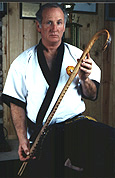
Mark Shuey Sr.
Self-Defense with a Cane. By J.N.C. Barton-Wright.
Self-Defense: Cane 1. Instructional DVD. Cane workshop by
Charles Davis.
The Stick and Cane in Close Combat.
By Tom Lang.
"The result of a
7-year intensive study of grappling techniques with the stick and cane, the book
presents more than 120 jointlocks, takedowns, chokes, holds, disarms, surprise
attacks, rolls, strikes, and exercises with the stick and cane in 750
photographs. These techniques were collected and refined from those described in
more than 120 books and videos on the topic as practiced in several traditions,
as well as from my 35+ years of experience in the martial arts. It is the
largest collection of these techniques yet published."
Strikes with the Stick and Cane. 60 strikes are described by Tom Lang.
87Kb, PDF.
Tai Chi Chuan Walking
Stick. Kung Fu magazine, August 1996. The walking
stick forms are part of the Tchoung style of t'ai-chi ch'uan, developed by Grandmaster
Tchoung Ta-tchen.
Sifu Kurland teaches this
form.
Tai
Chi Partner Cane Form. By Sifu Michael Gilman, Port Townsend, Washington.
Detailed instructions with b&w photographs online. An instructional
videotape is also available for Sifu Gilman. "This is a useful, short (11
movements per side) partner form. When the transition is added, one ends up with
a beautiful, instructive partner or solo form. These lessons are divided into
sections. The first is the Introduction and all the applications for the form.
The second and third sections break down each of the two sides and teach the
movements. The last section shows the form performed as a partner
form. Keep in mind that there is a companion VHS video tape available through
the on-line store."
Taiji Zhang: Japanese, Chinese, and Okinawan Styles. Instructional
DVD, 2006. By Christopher Keith and James Bouchard.
Traditional Tai Chi Eight Immortals Cane, Routine One. Demonstrated by
Master Jesse Tsao. Instructional DVD, 64 minutes. Produced by
Tai Chi Healthways,
San Diego, 2008. Routine One is based on the Yang Style of Taijiquan.
Traditional Tai Chi Eight Immortals Cane, Routine Two (Cannon Cane).
Demonstrated by Master Jesse Tsao. Instructional DVD, 65 minutes.
Produced by Tai Chi
Healthways, San Diego, 2008. Routine Two, Cannon Cane, is based on the
Chen Style of Taijiquan.
Videos on U Tube:
Tai Chi Cane,
Taijiquan Cane,
Hapkido Cane
Walkiing Cane
Information: History, Facts, and Usage of Canes
Beifang Qi Taiji Zhang means "Northern Energy Taiji Cane". Instructional DVD. "This exciting original form was created by James Bouchard to introduce the cane to Taiji practitioners, and to introduce Taiji principles to martial artists interested in the cane. Beifang Qi includes sets of "Qigong" or "energy exercises", multiple views of the form and a complete section on basic applications. Each movement is named for easy reference and the DVD version includes interactive menus. Beifang Qi Taiji Zhang is appropriate for novices, yet experienced martial artists will find new levels of understanding. Endorsed by Cane Masters International."
Cane Notes and Information
"So what are the areas that a "CaneMaster" excels in? All
Master level cane practitioners excel in cane self defense, teaching ability,
exercising with the cane and natural healing. By taking a look at three of the
pioneers of the art of the cane and the way in which they present their art, we
find the commonalities that define the masters. GM Dave Mcneil of Goju Shorei
has made the isometric cane exercises and stretches an integral part of
conditioning for the cane in his system. He has also incorporated "seikufujutsu"
a type of Japanese restorative massage as part of his advanced dan requirement.
Of course, the self defense tecniques and kata are the foundation of the system.
GCM Shuey of the CMIA, in addition to the self defense techniques and kata
incorporates cane isometrics, stretches, cane exercise bands for resistance
training and has entered the physical rehabilitation arena with his unique cane
exercise system to the point where some medical insurance companies have offered
reimbursement for his programs. GCM Shuey has brought the cane to the general
public beyond its self defense and fitness context. Anyone who uses the cane as
a medical aid can now turn it into a valuable equalizer. CM Robaina of the
Cane-Do Kai likewise presents the cane as a complete martial art that offers
self -defense, personal fitness and natural healing. Robaina who owns the Cane
Masters Cane-Do Kai dojo in Miami, actually has a personal fitness and healing
practice revolving around the cane. Robaina integrates cane stretches,
isometrics, exercise bands and a yoga-pilates like cane exercise system. He also
developed the "Quantum Cane" energy healing technique that he currently teaches
to lay people as well as licensed health care professionals. CM Robaina holds
the credentials to bring this system to the public since he is a degreed
exercise physiologist, Master of Sports Science, certifed Specialist in
Performance Nutrition, Licensed Massage Therapist, and Board Certified Doctor of
Naturopathy. So based on the approach of three of the premiere cane exponents
today we can agree that a CaneMaster is a teacher of self protection, personal
exercise, healing, and recuperative technques. A valuable contributor of good to
society."
- The CaneMaster: A
Self Defense Expert, Fitness Teacher, and Healer.
![]()
Return to the Index at the Top of This Webpage
![]()
Valley
Spirit T'ai Chi Ch'uan Club
Red Bluff, Tehama County, North Sacramento Valley, Northern Central California,
U.S.A.
Cities in the area: Oroville, Paradise, Durham, Chico, Hamilton City, Orland,
Willows, Corning,
Rancho Tehama, Los Molinos, Tehama, Proberta, Gerber, Manton, Cottonwood,
Anderson, Shasta Lake, Palo Cedro, and Redding, CA, California.
© Michael P. Garofalo, 2003-2012, All Rights Reserved
The information on this webpage was first published on the Internet in March of 2003.
This webpage was last modified or updated on September 17, 2014.
Qigong: Links and Bibliography
Cloud Hands: T'ai Chi Ch'uan and Chi Kung Website
Sun Style of Taijiquan and Qigong
Chen Style Taijiquan and Qigong
Biography of Michael P. Garofalo
Valley Spirit Taijiquan, Red Bluff, California
Detailed Index to the Cloud Hands Website